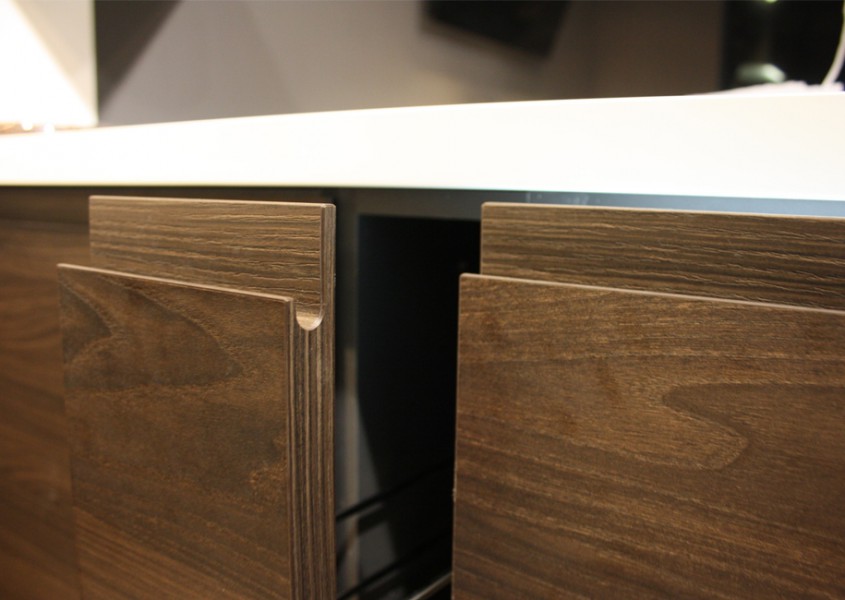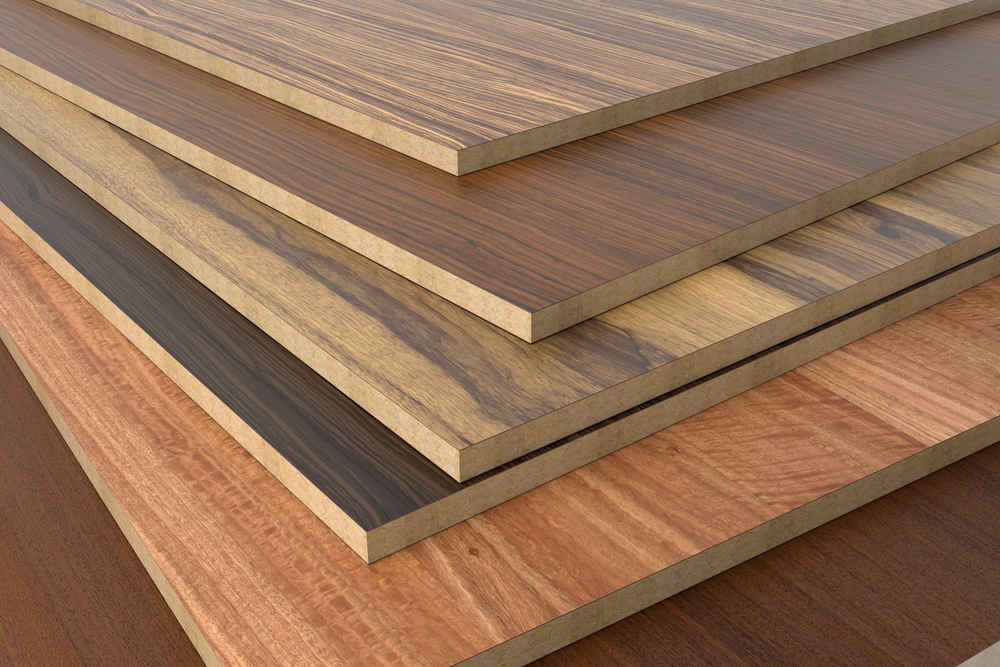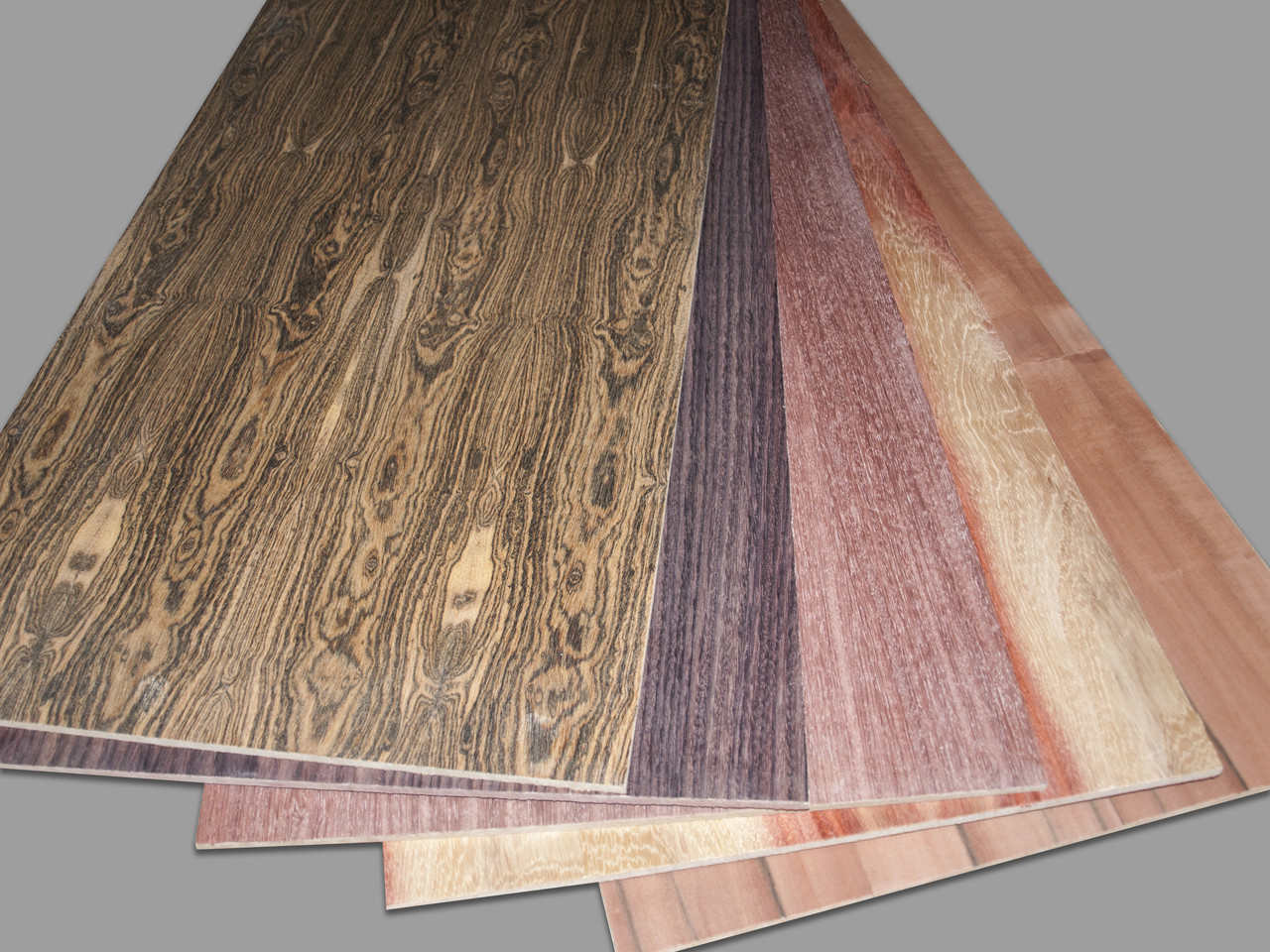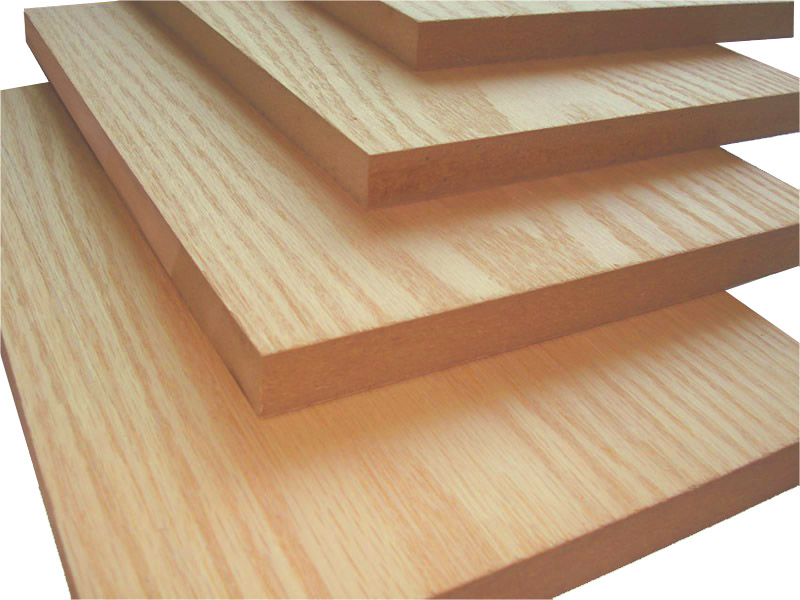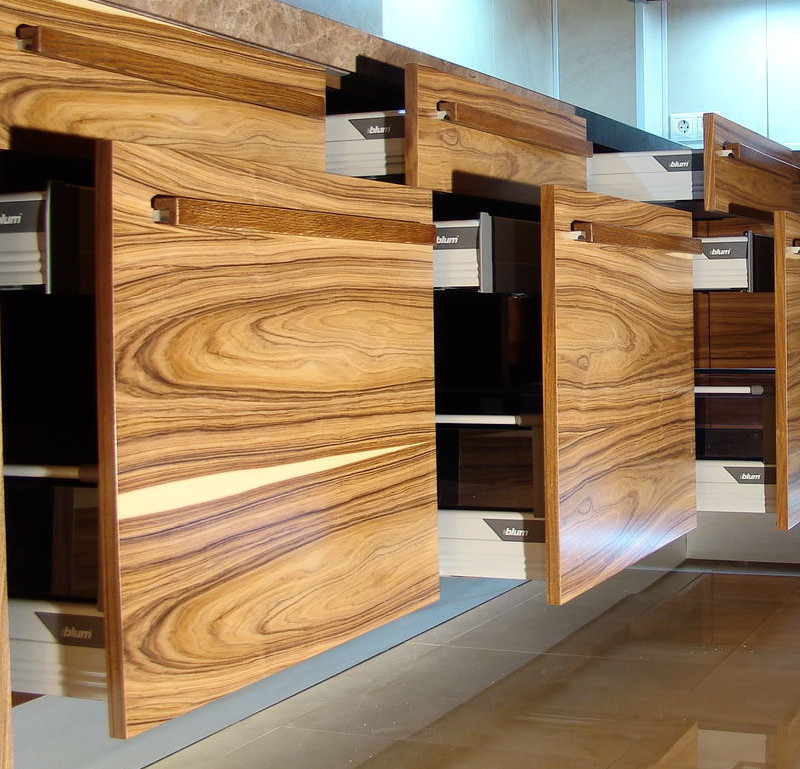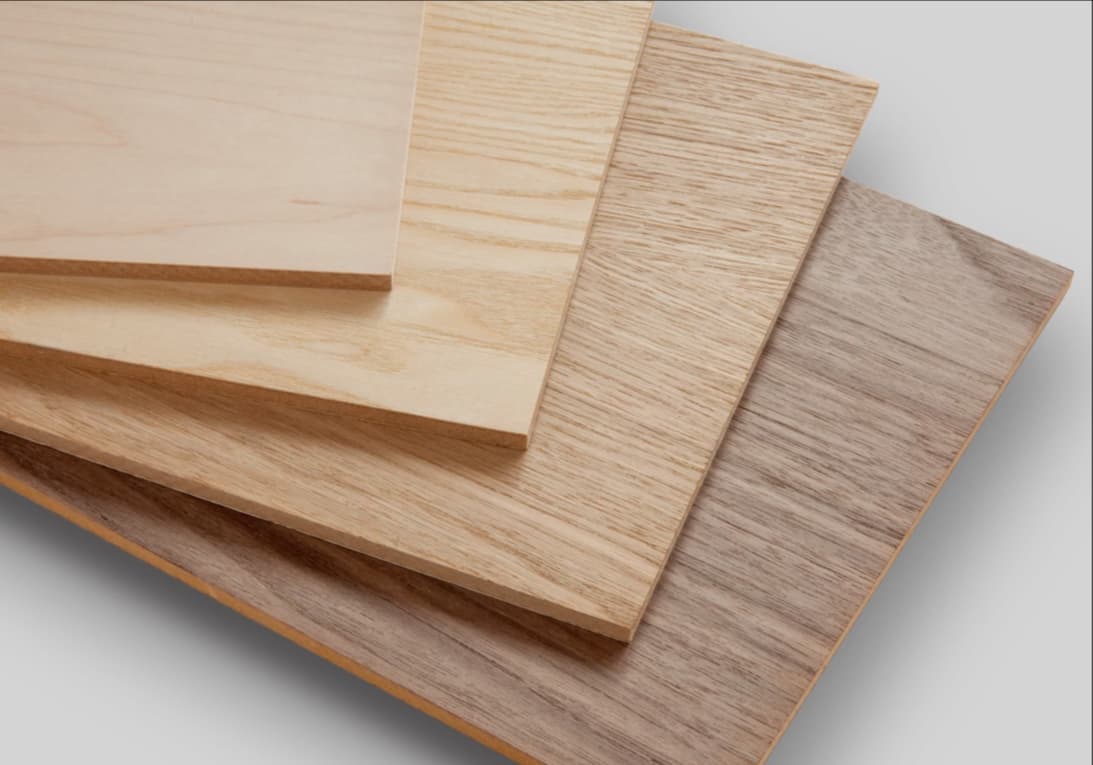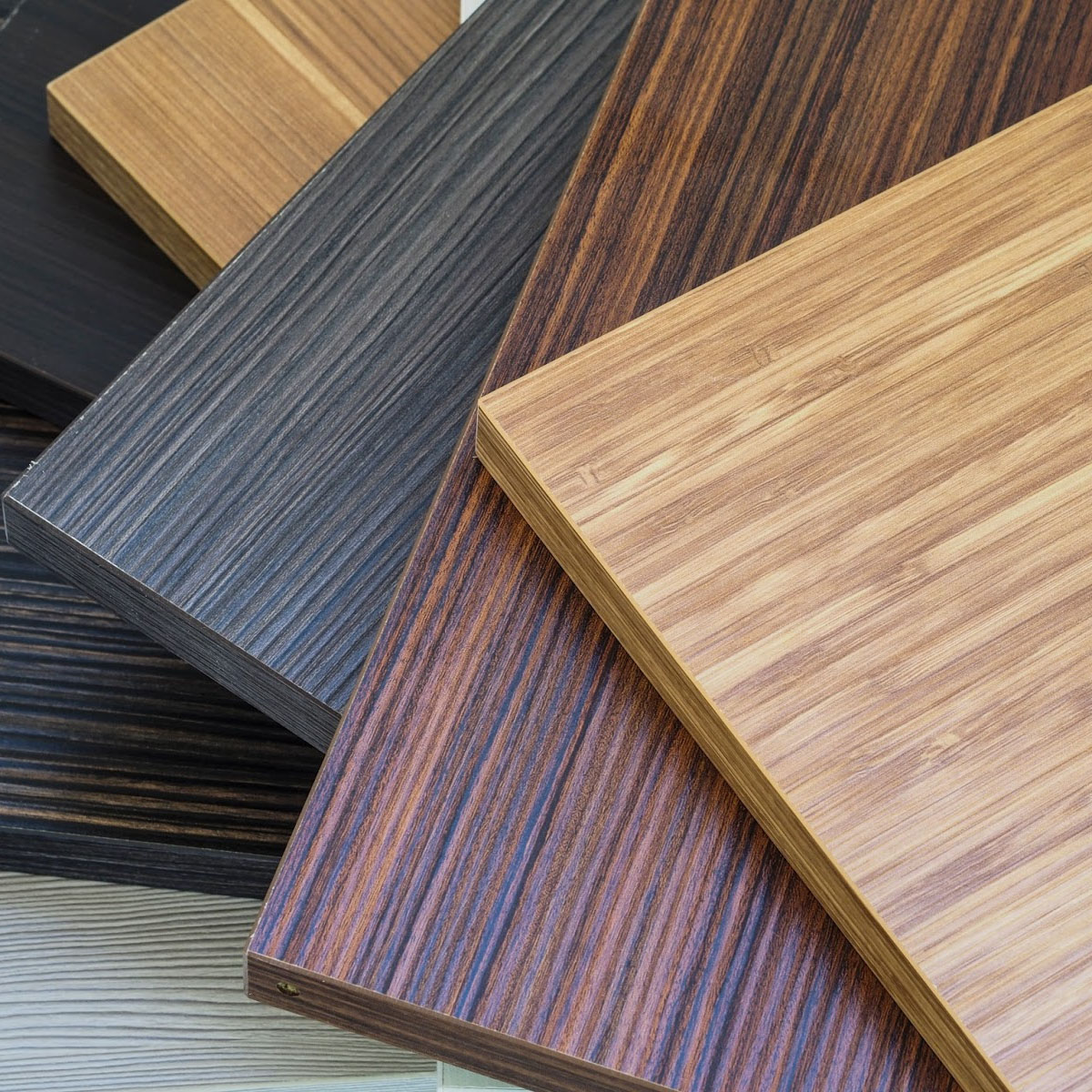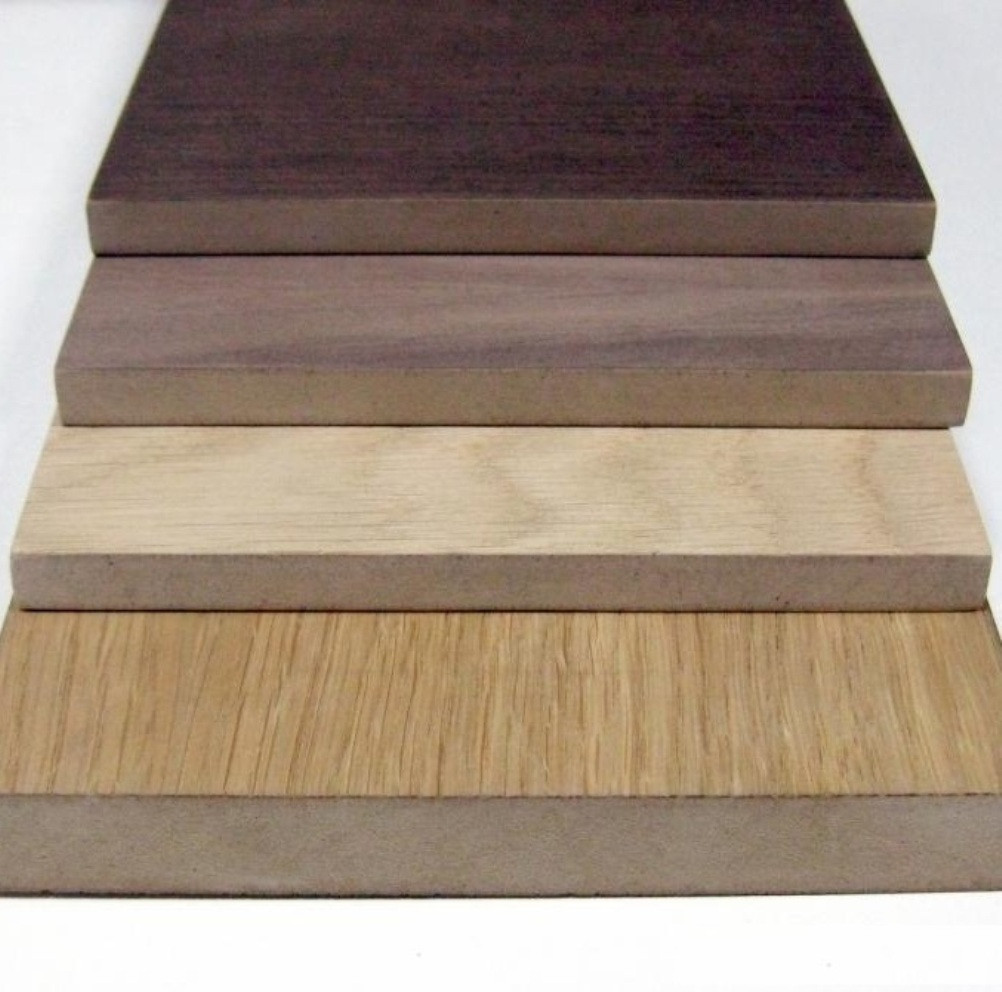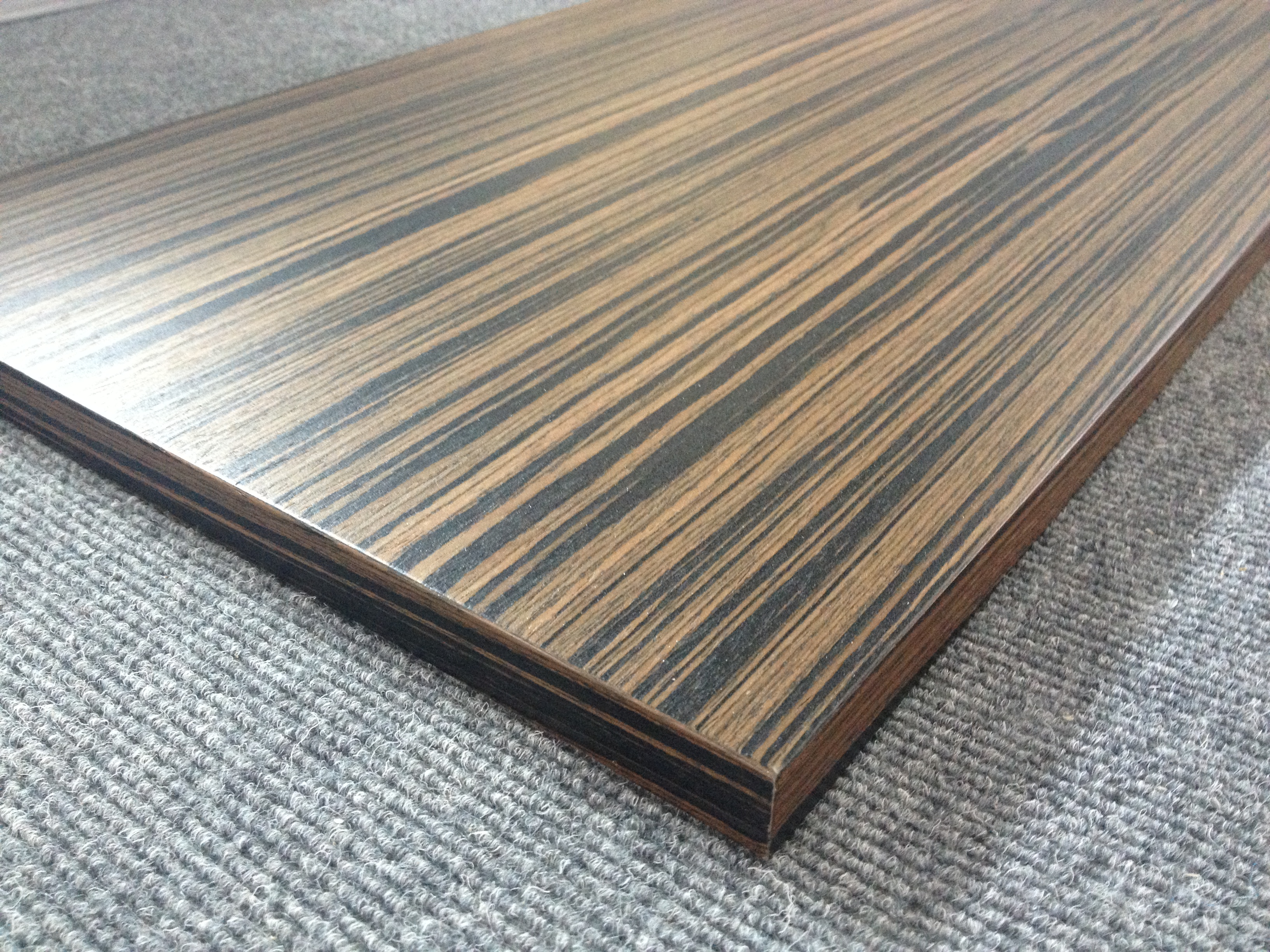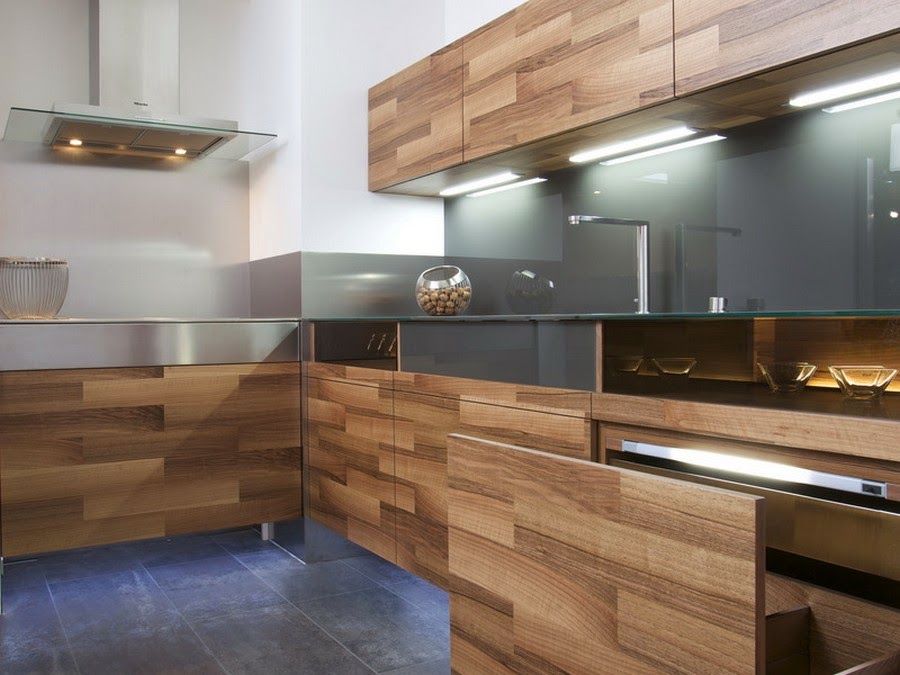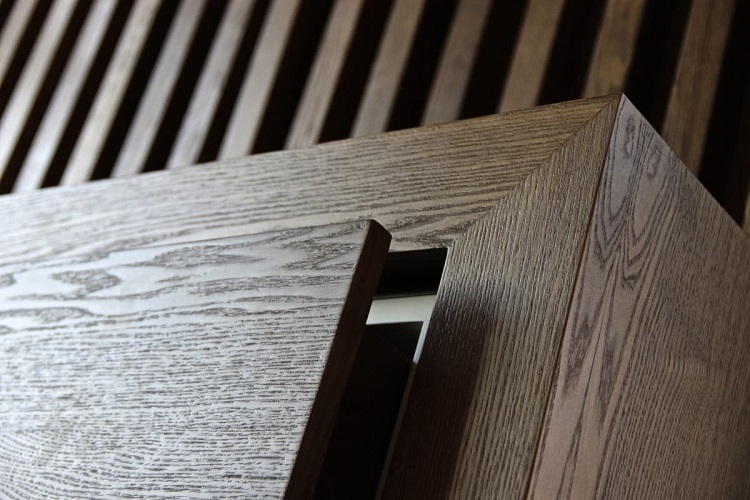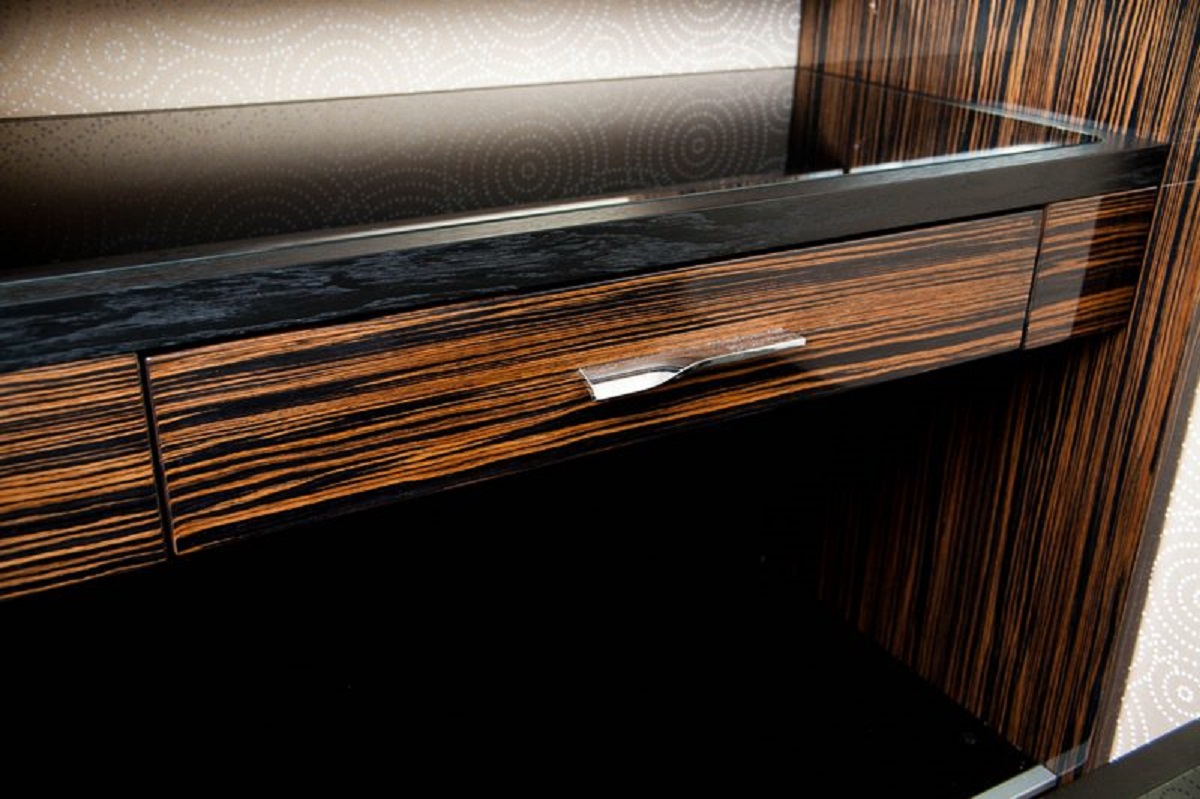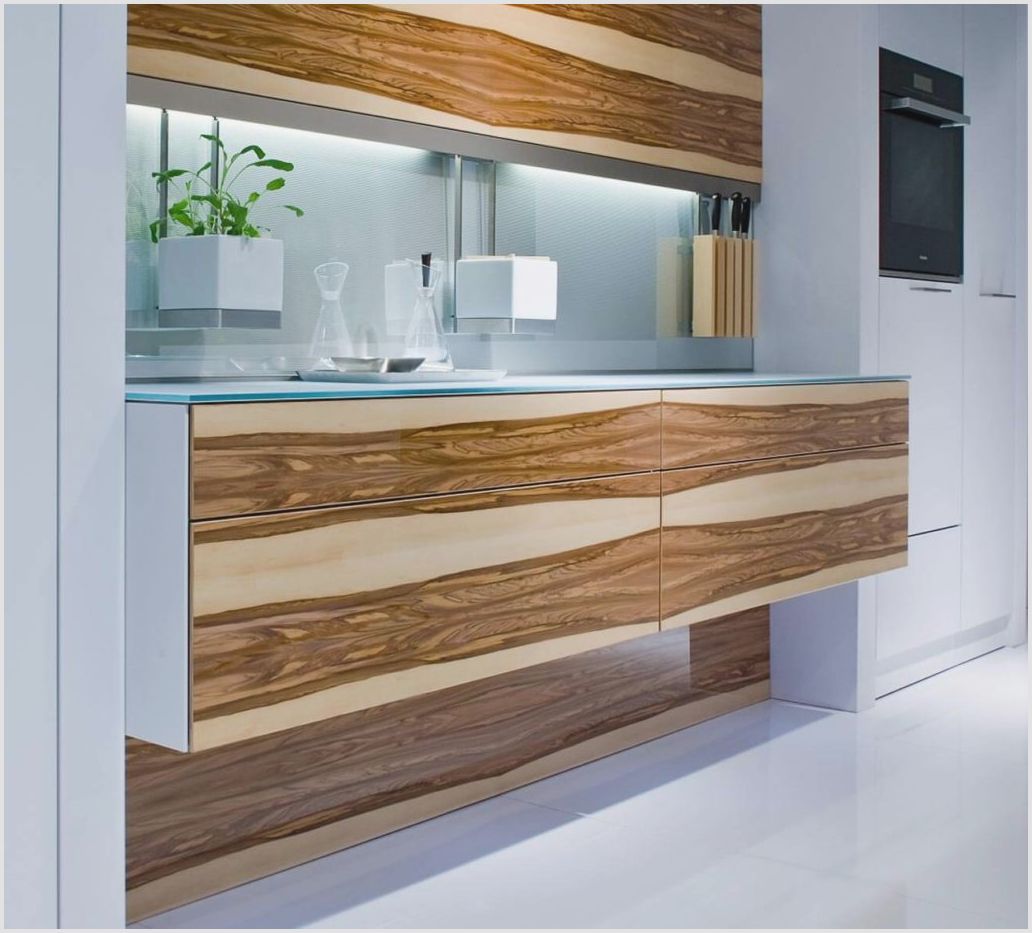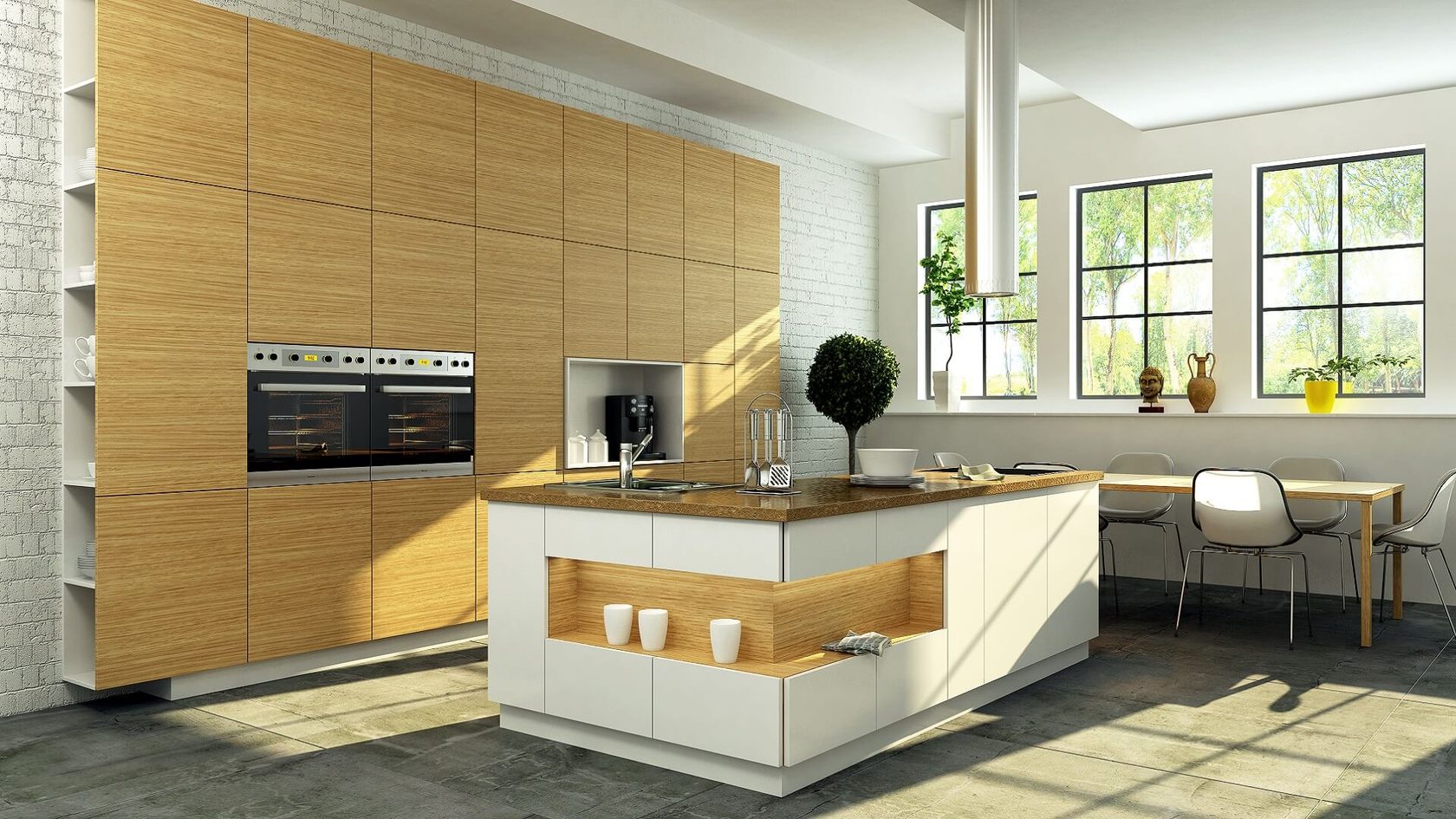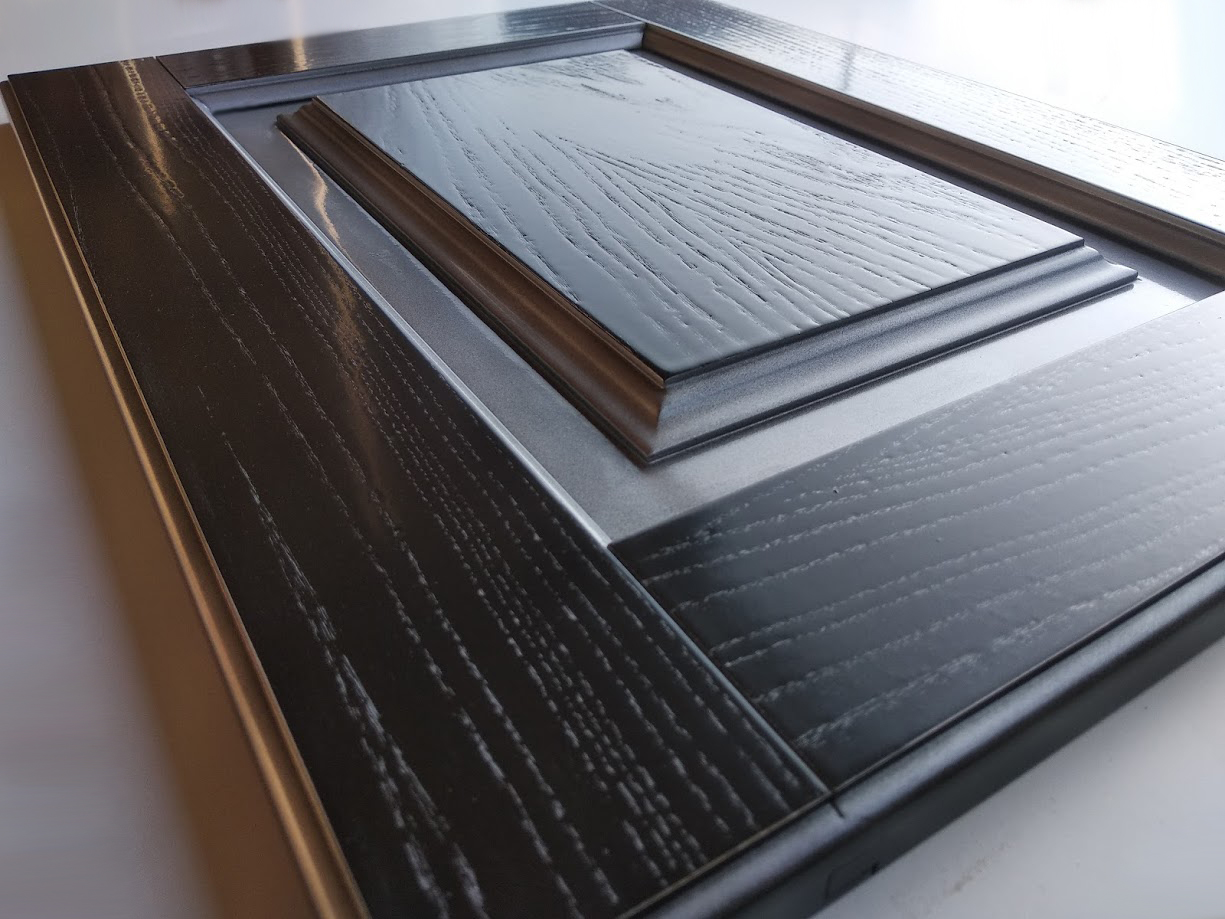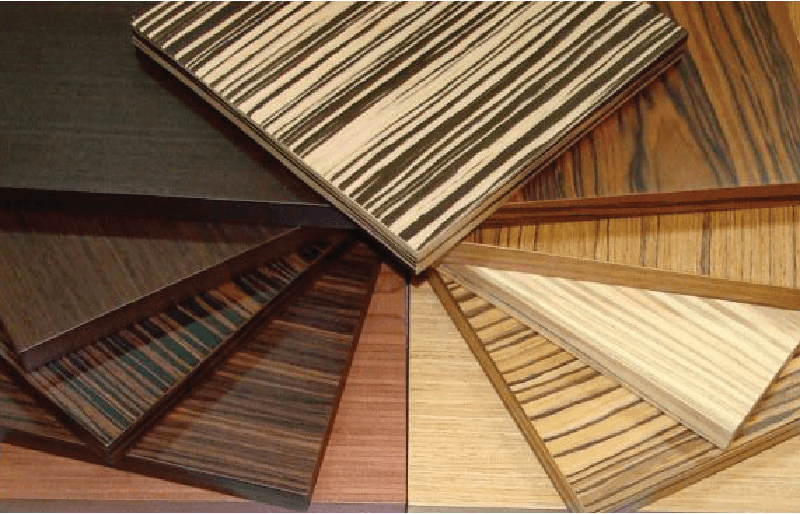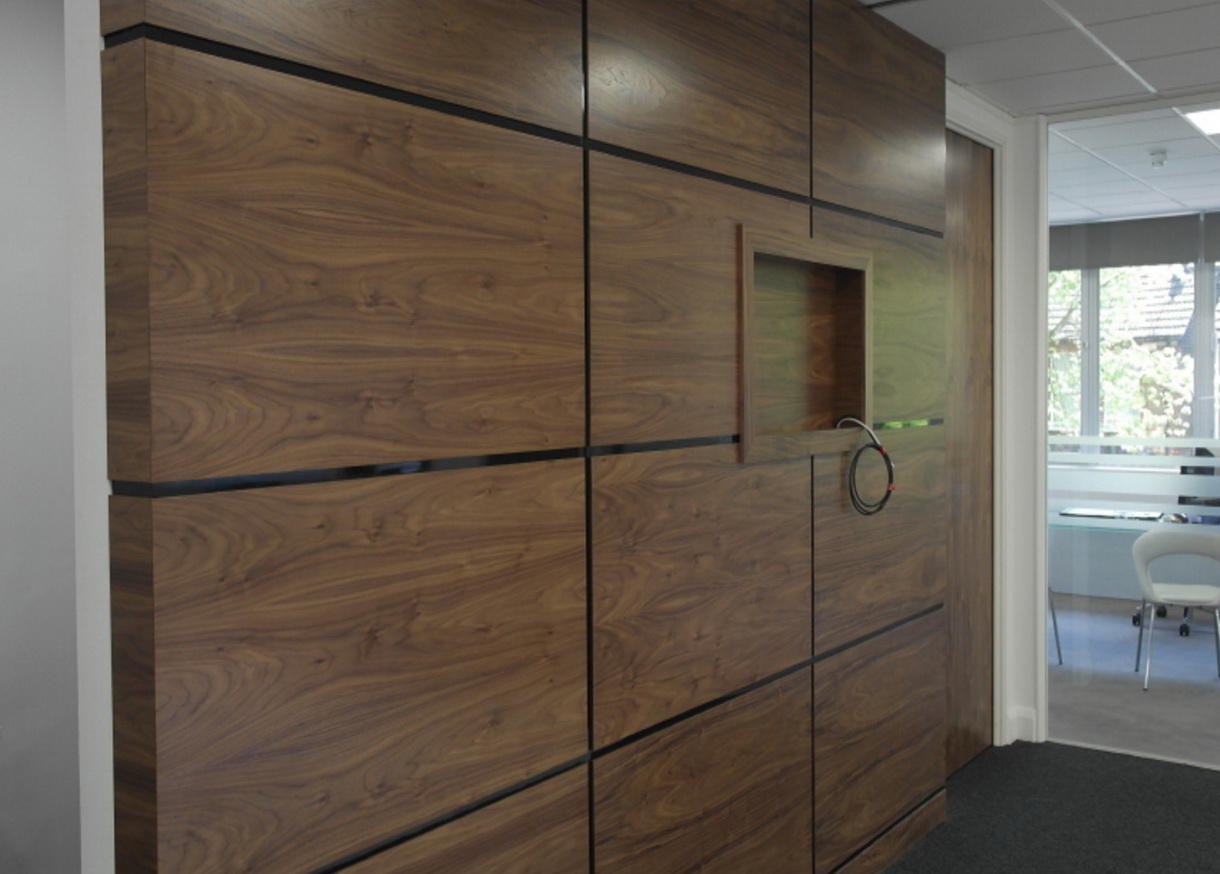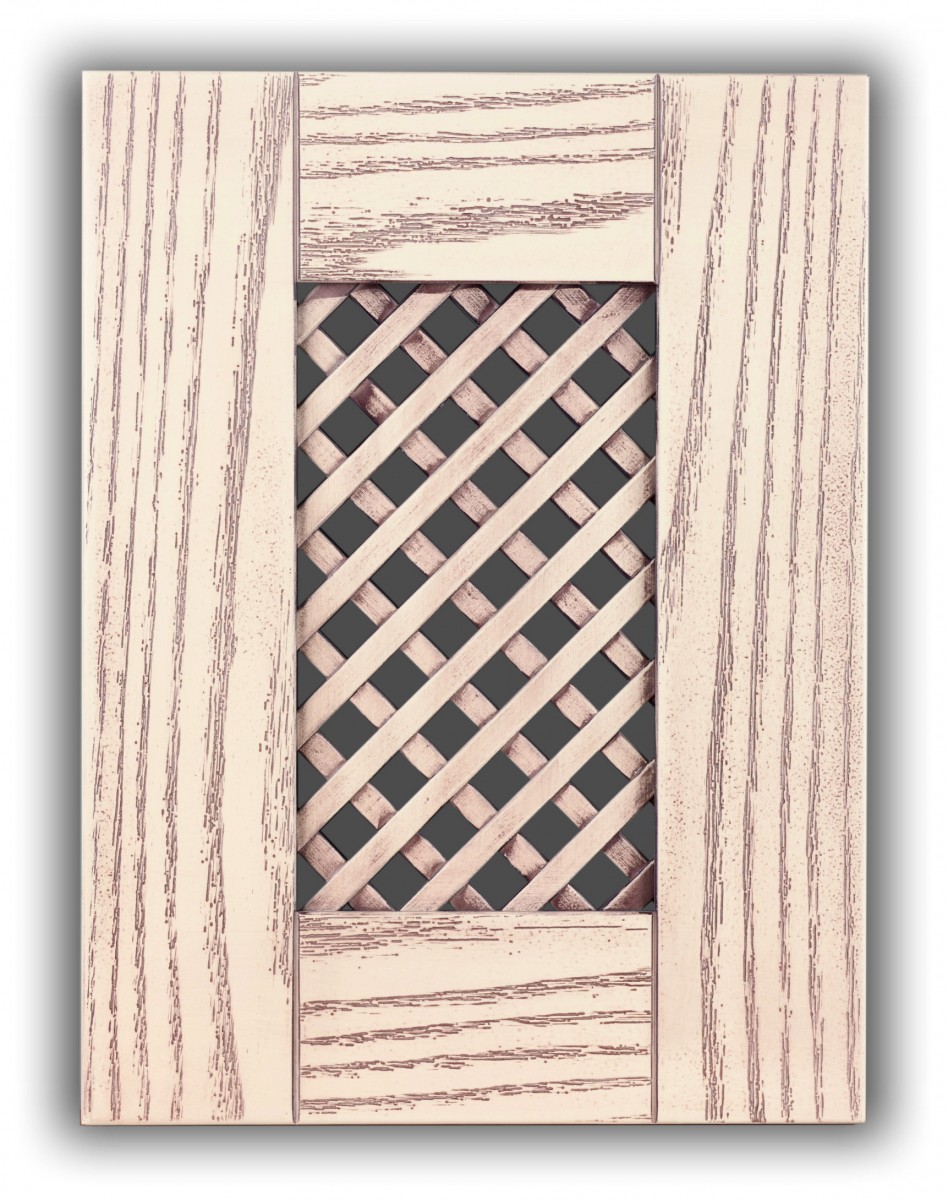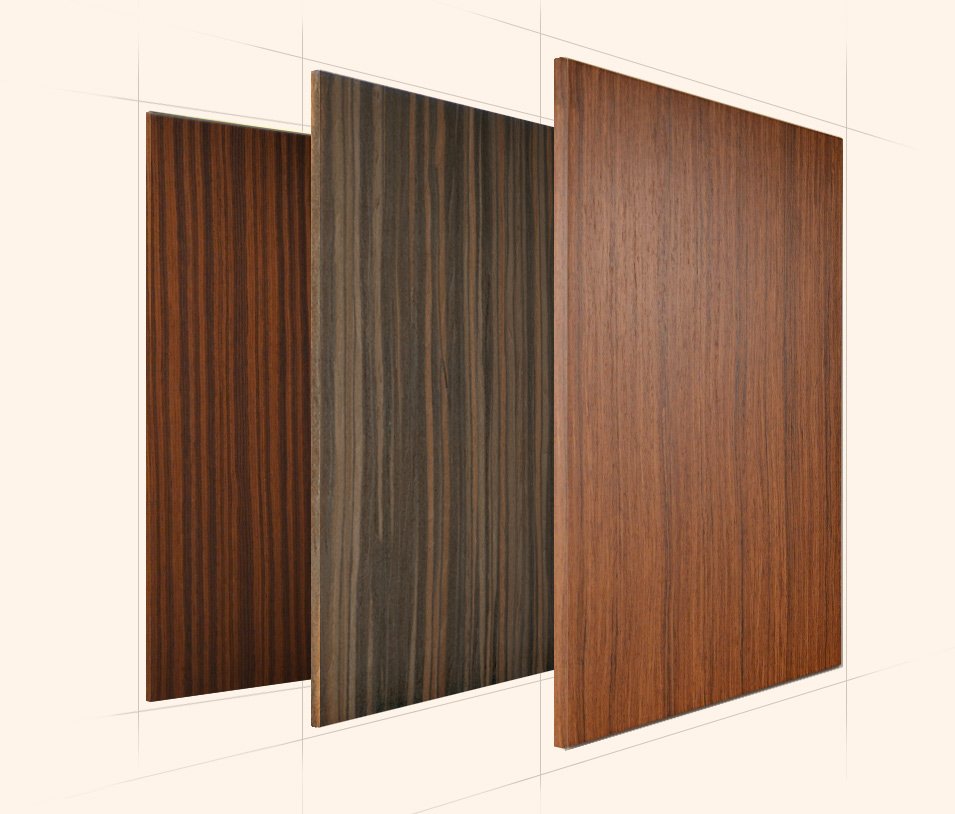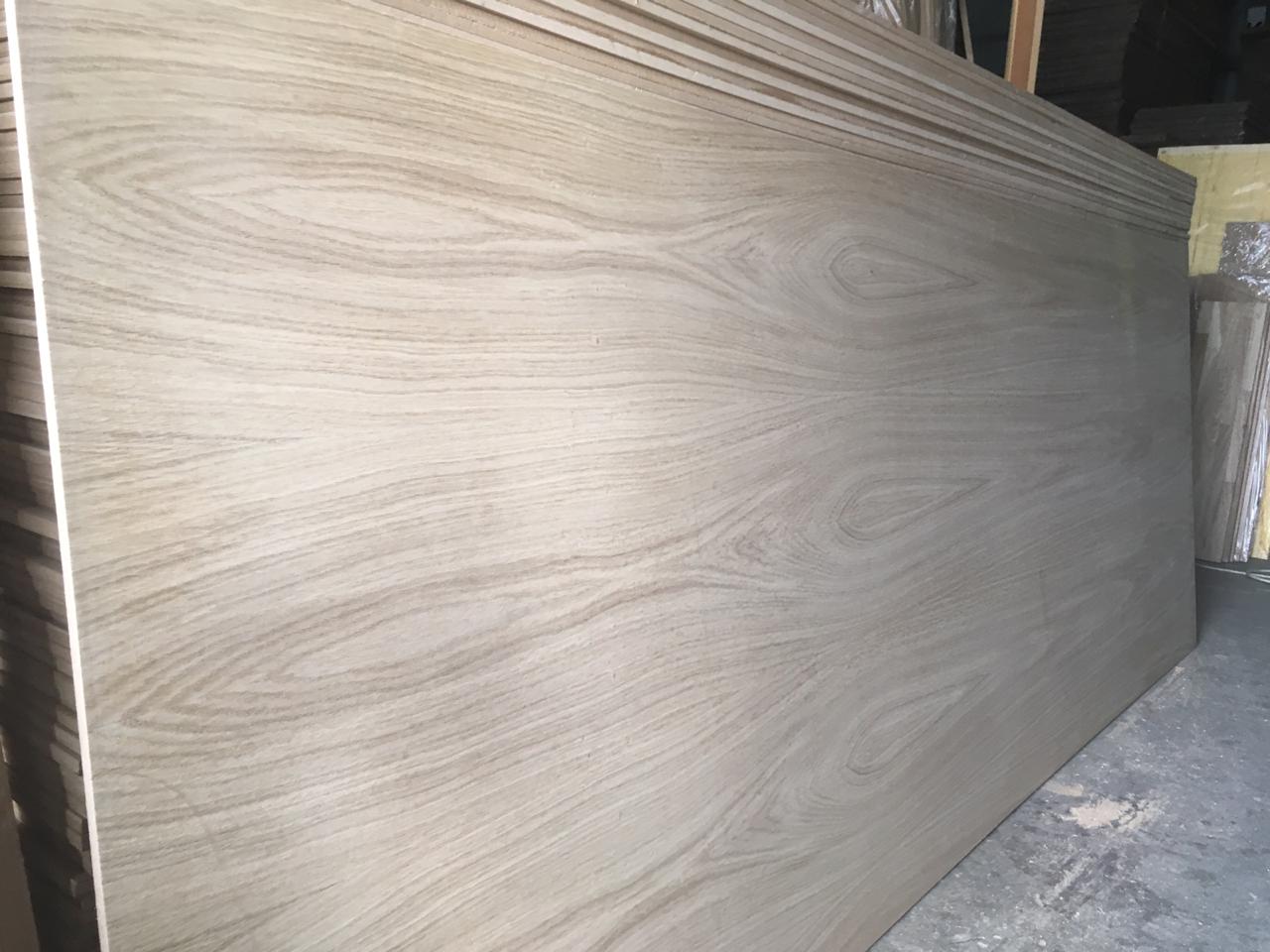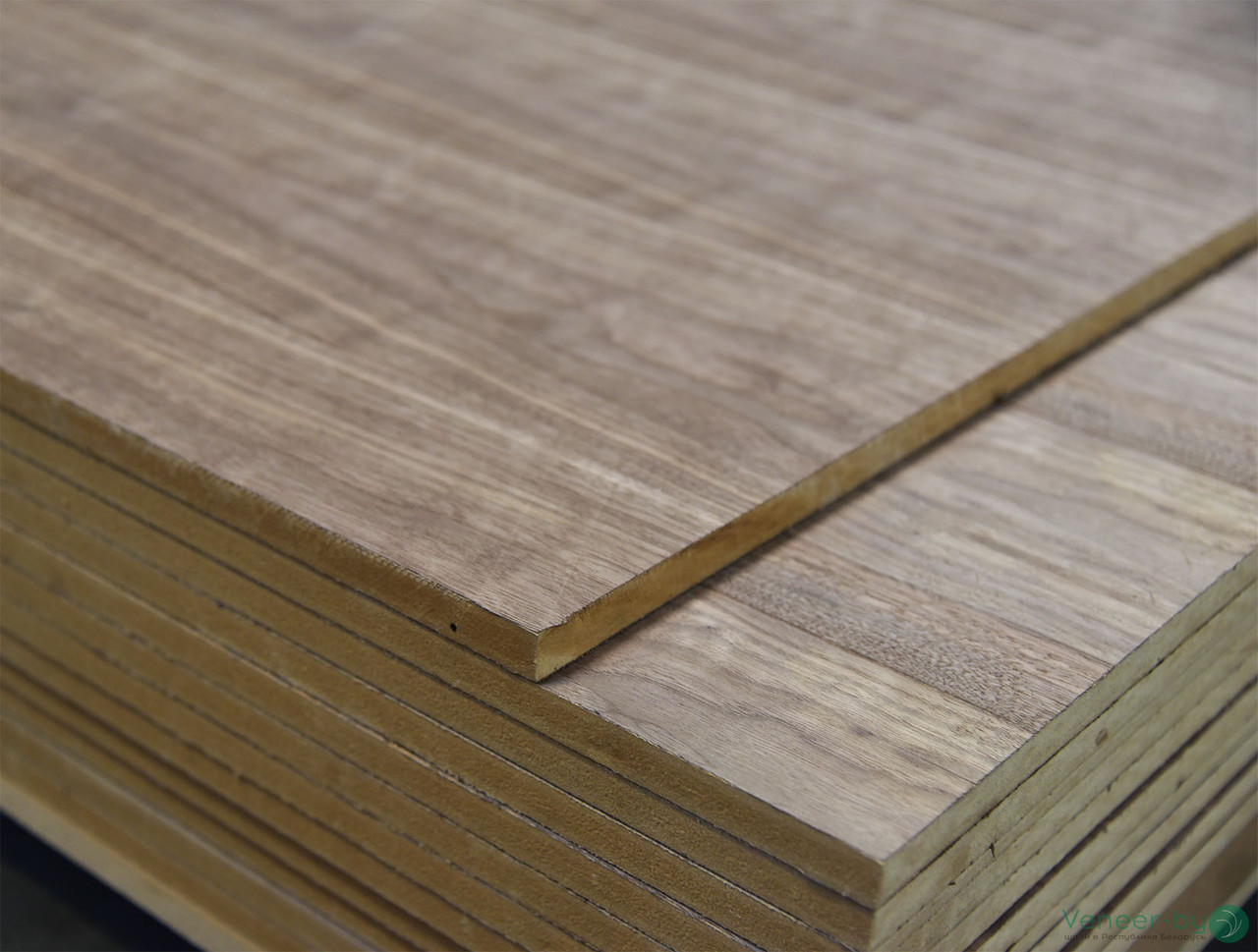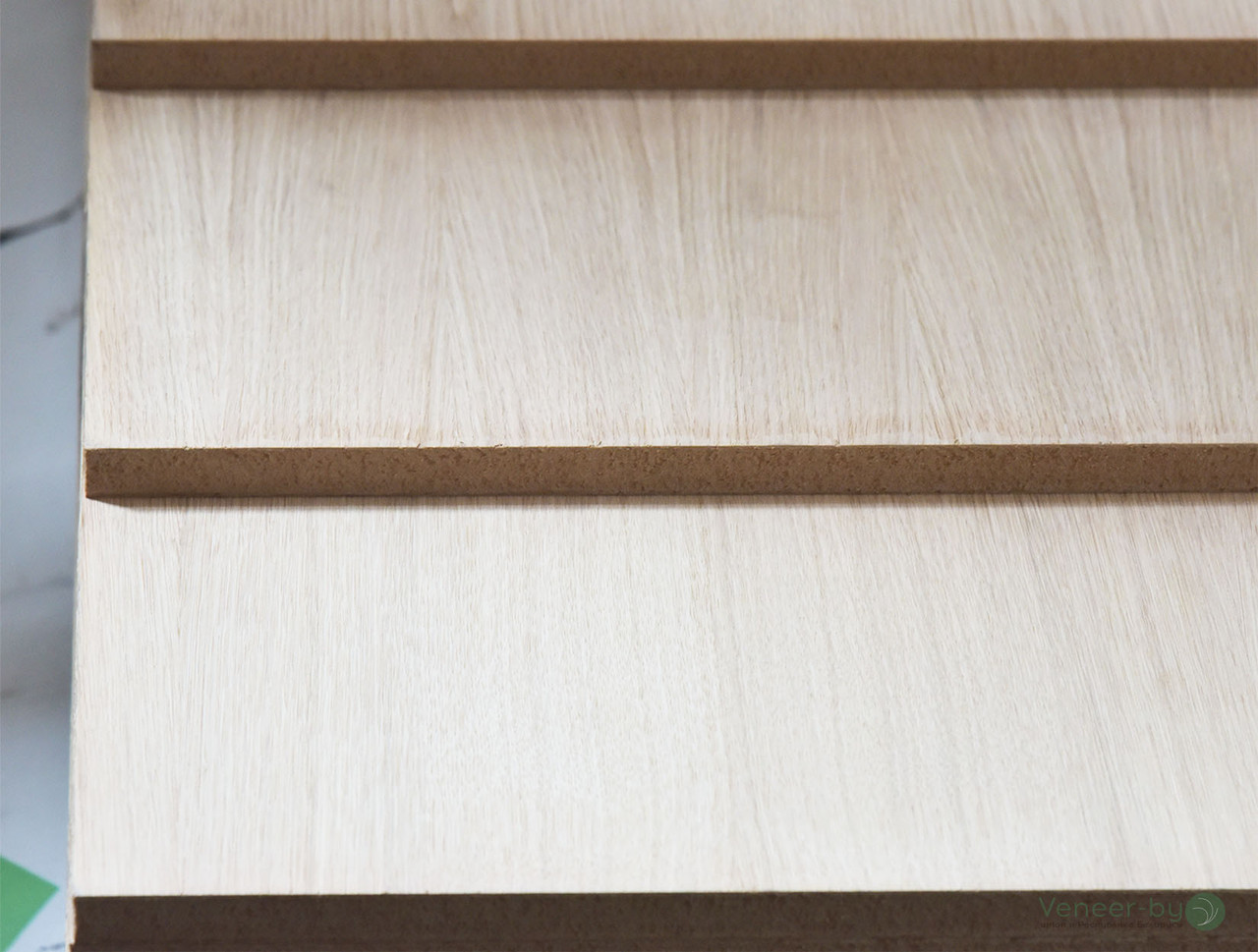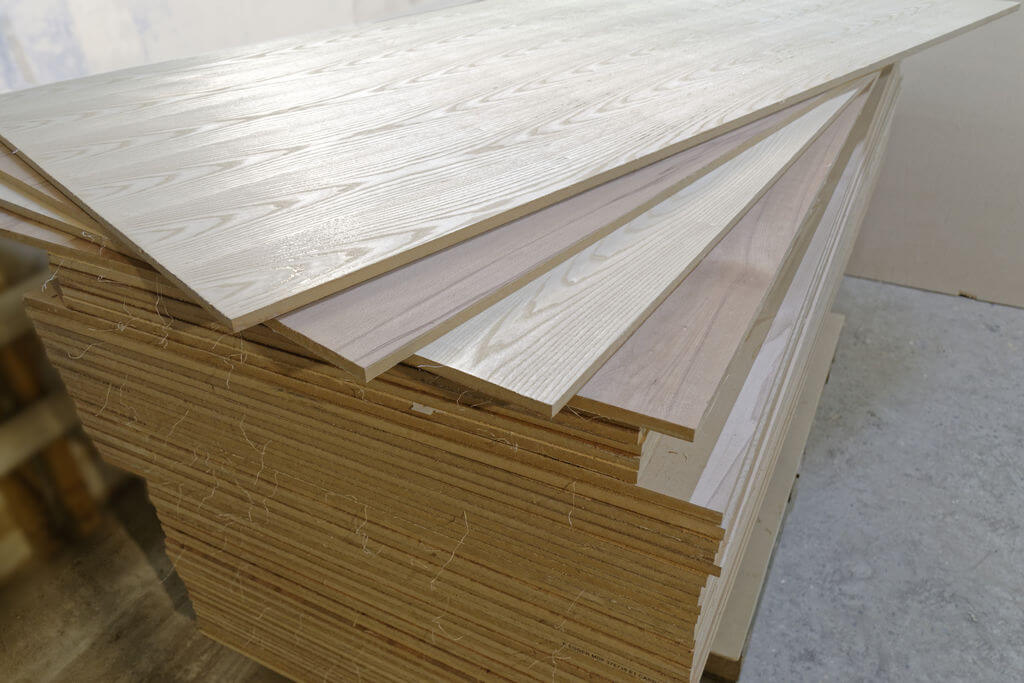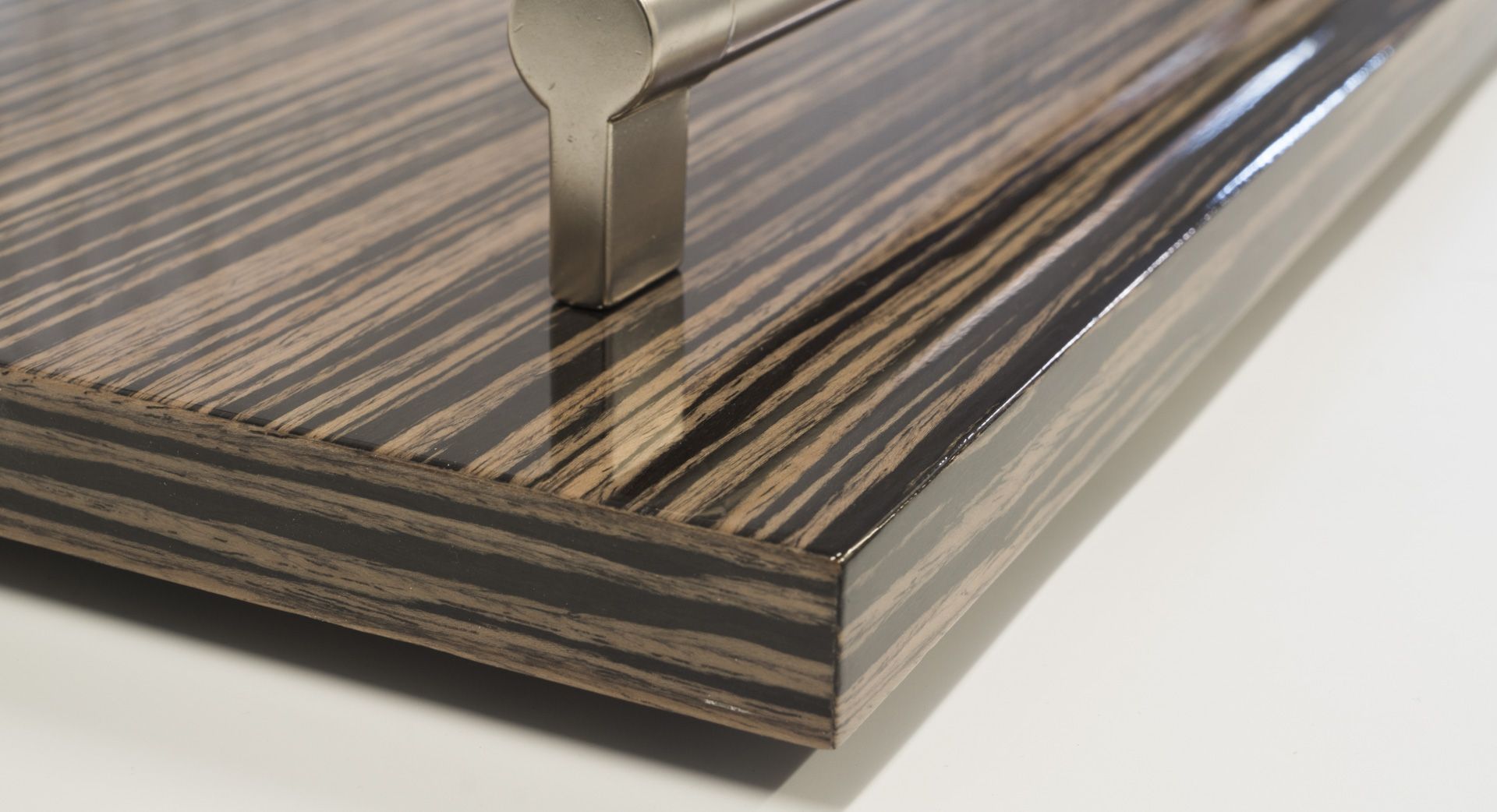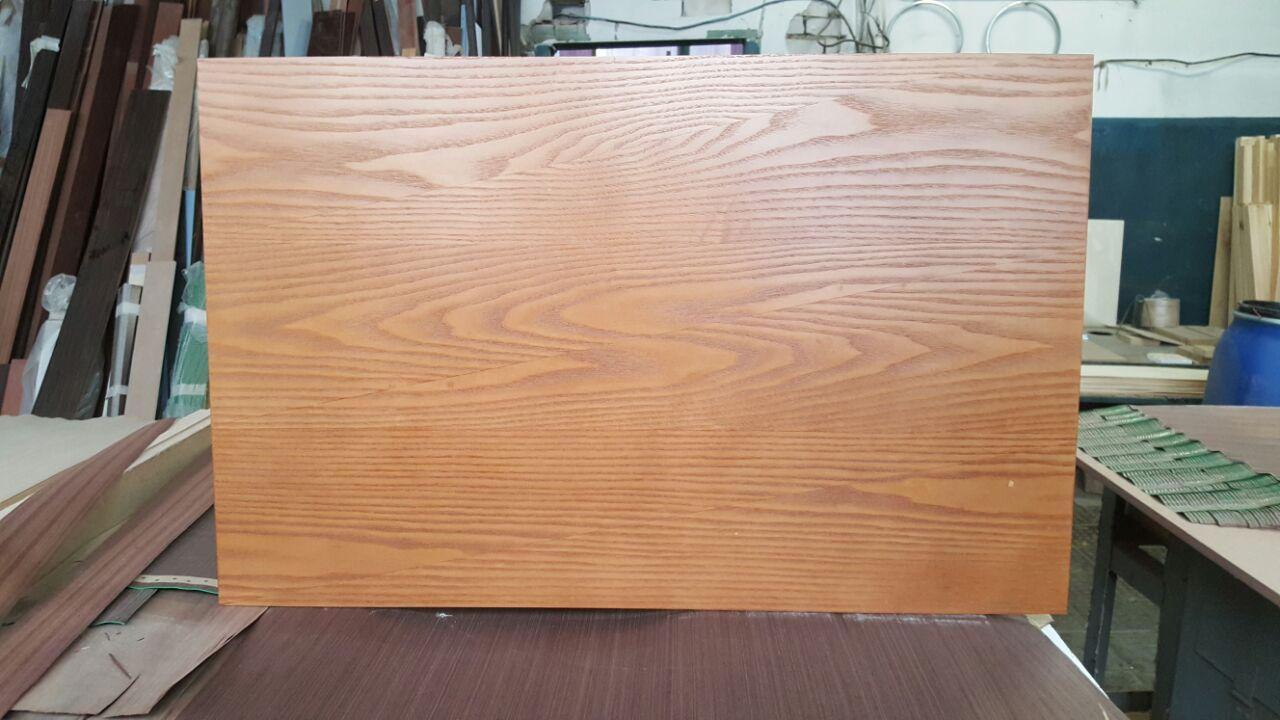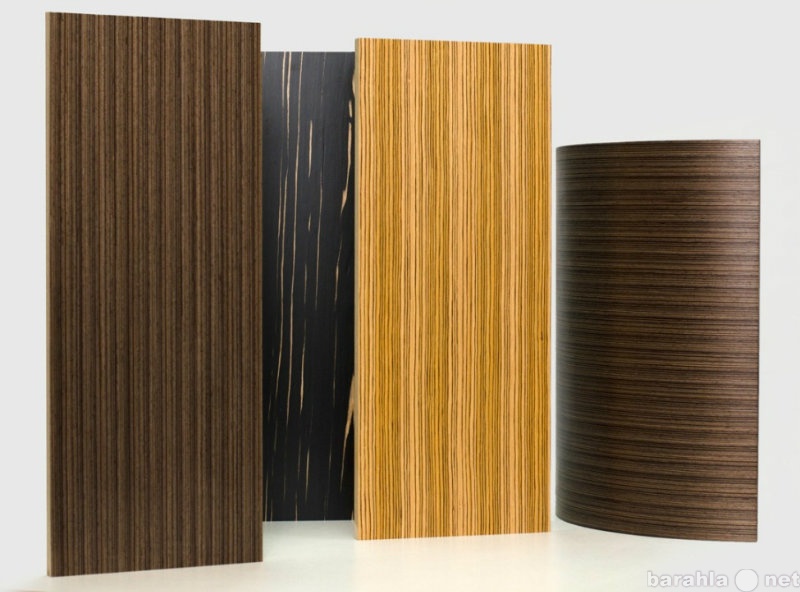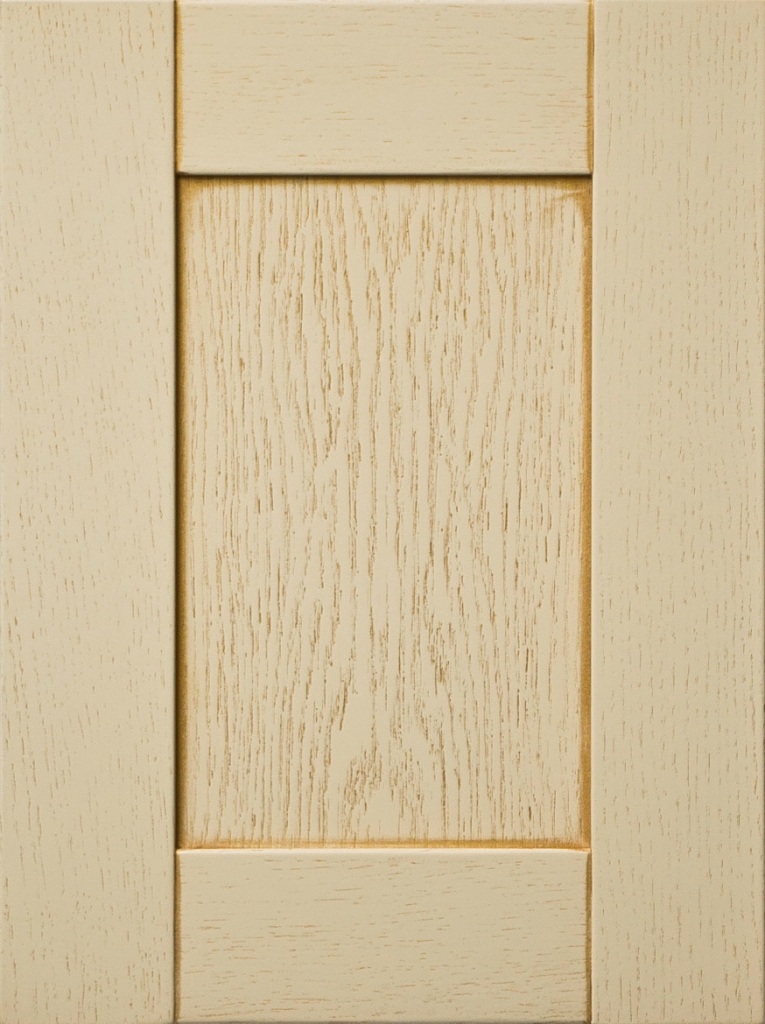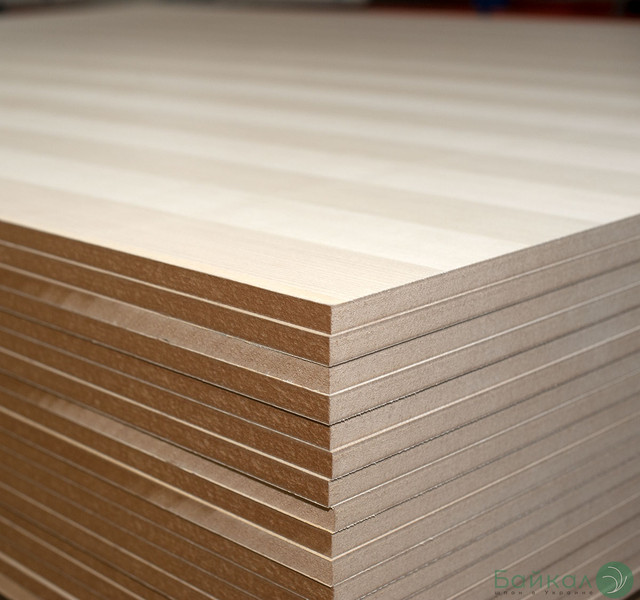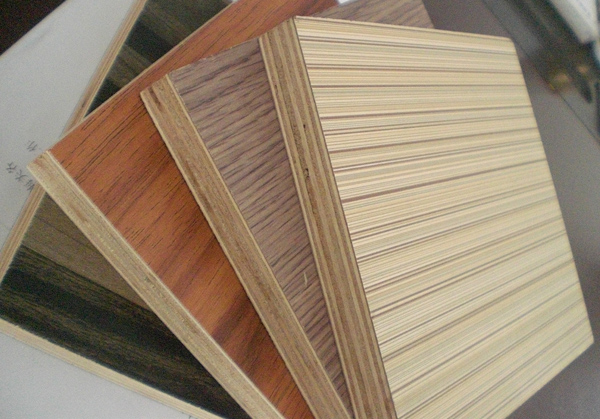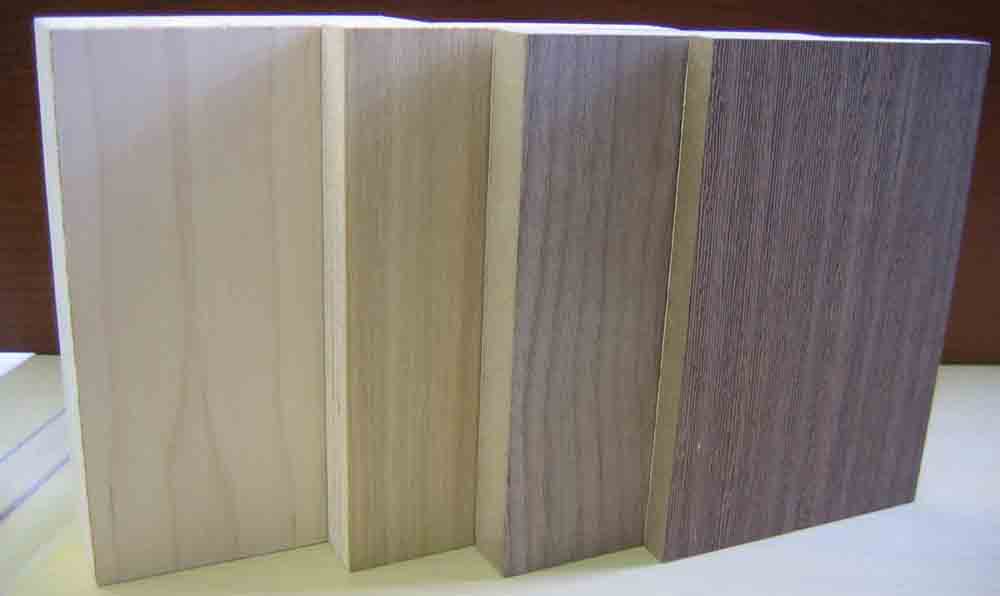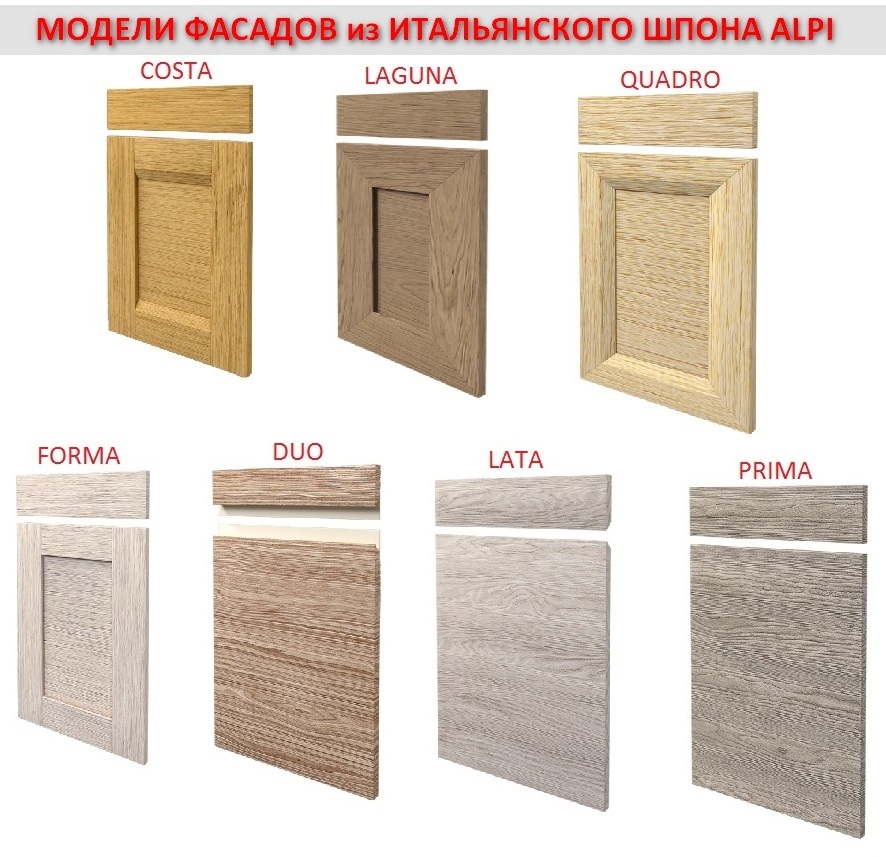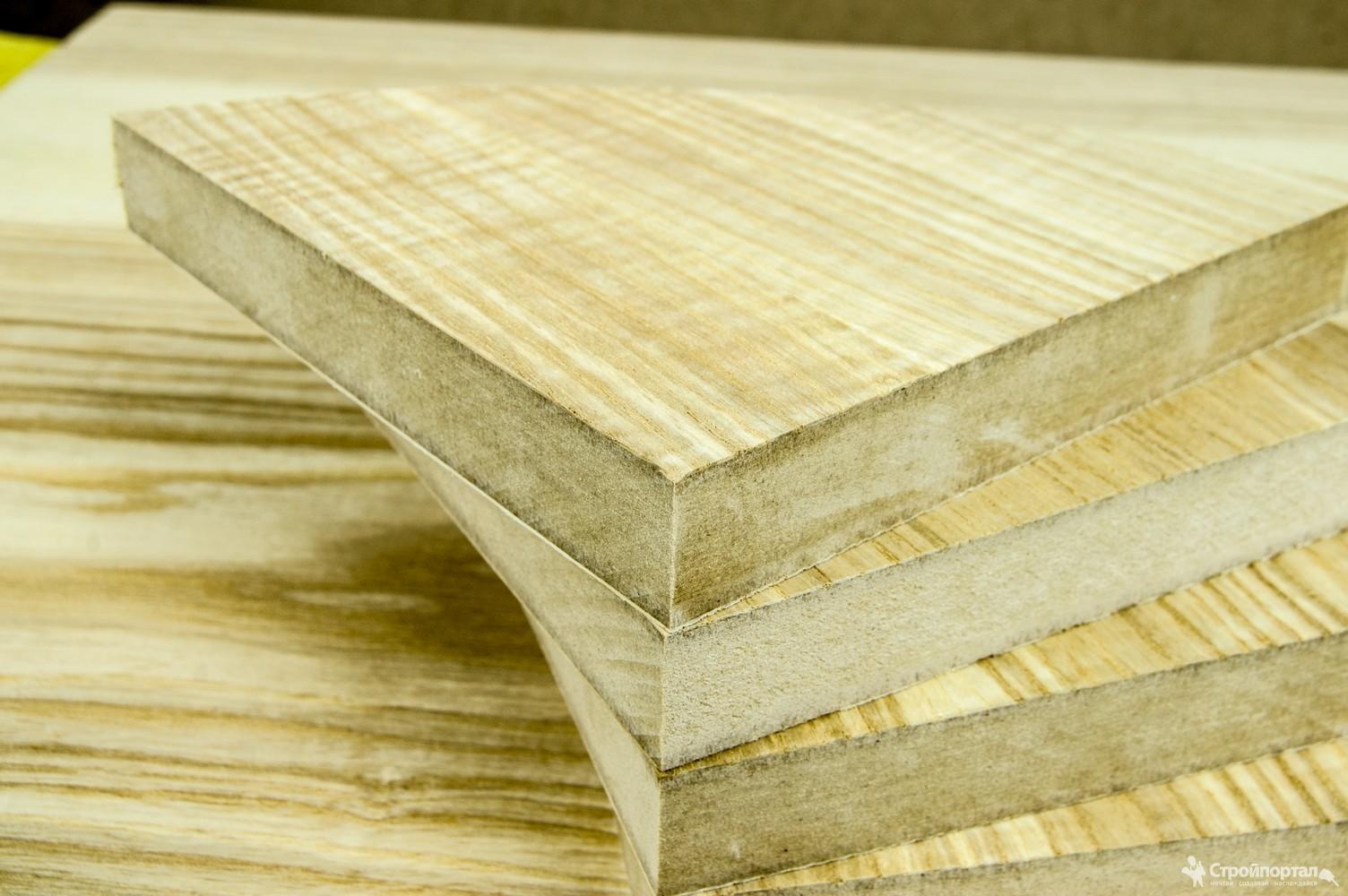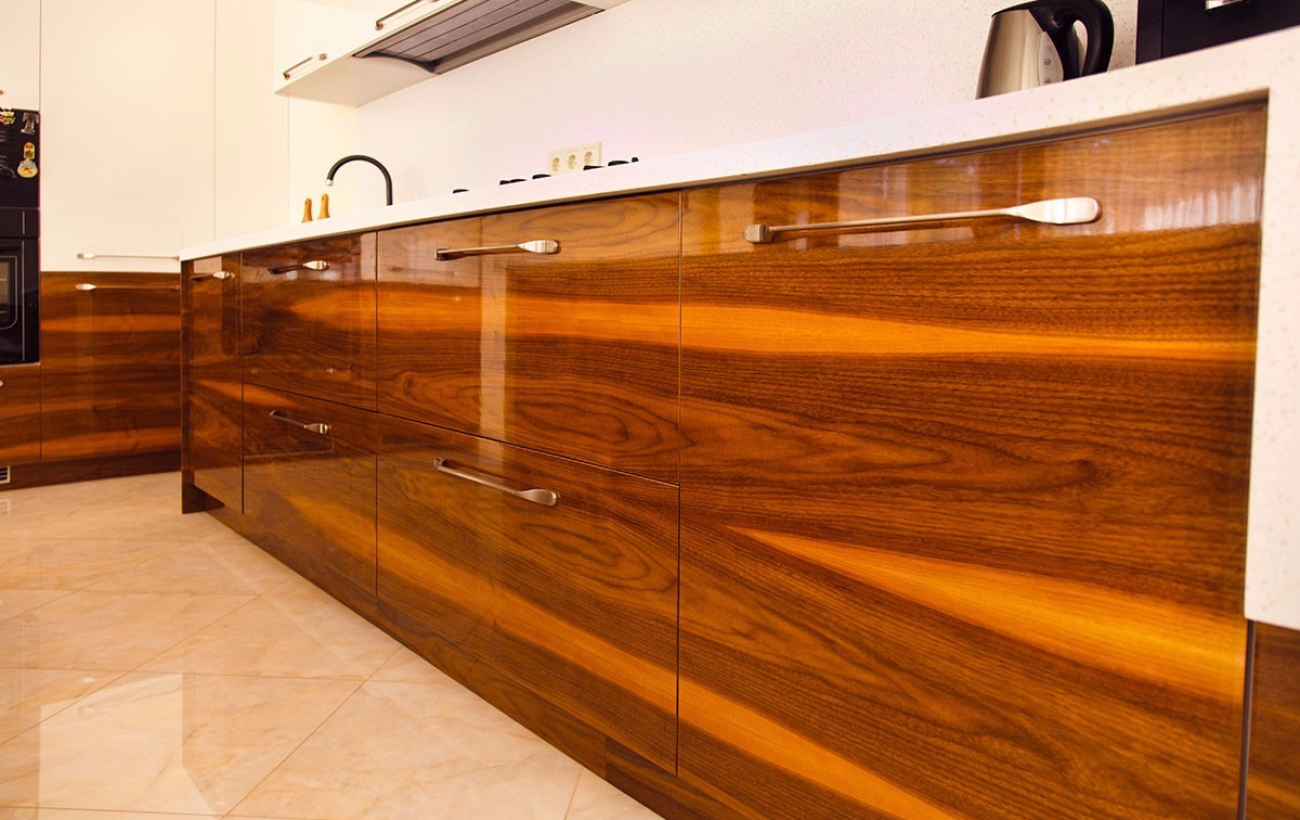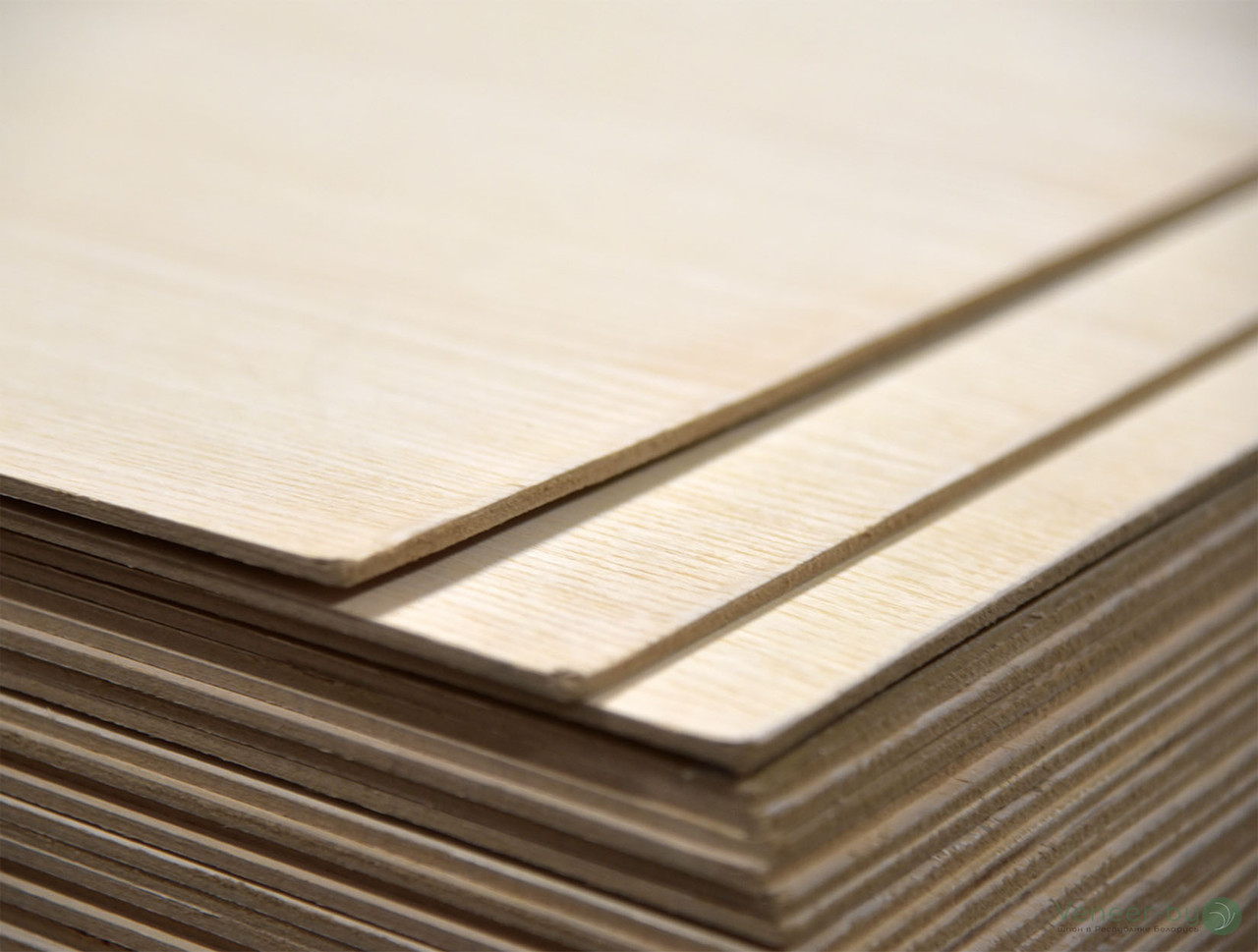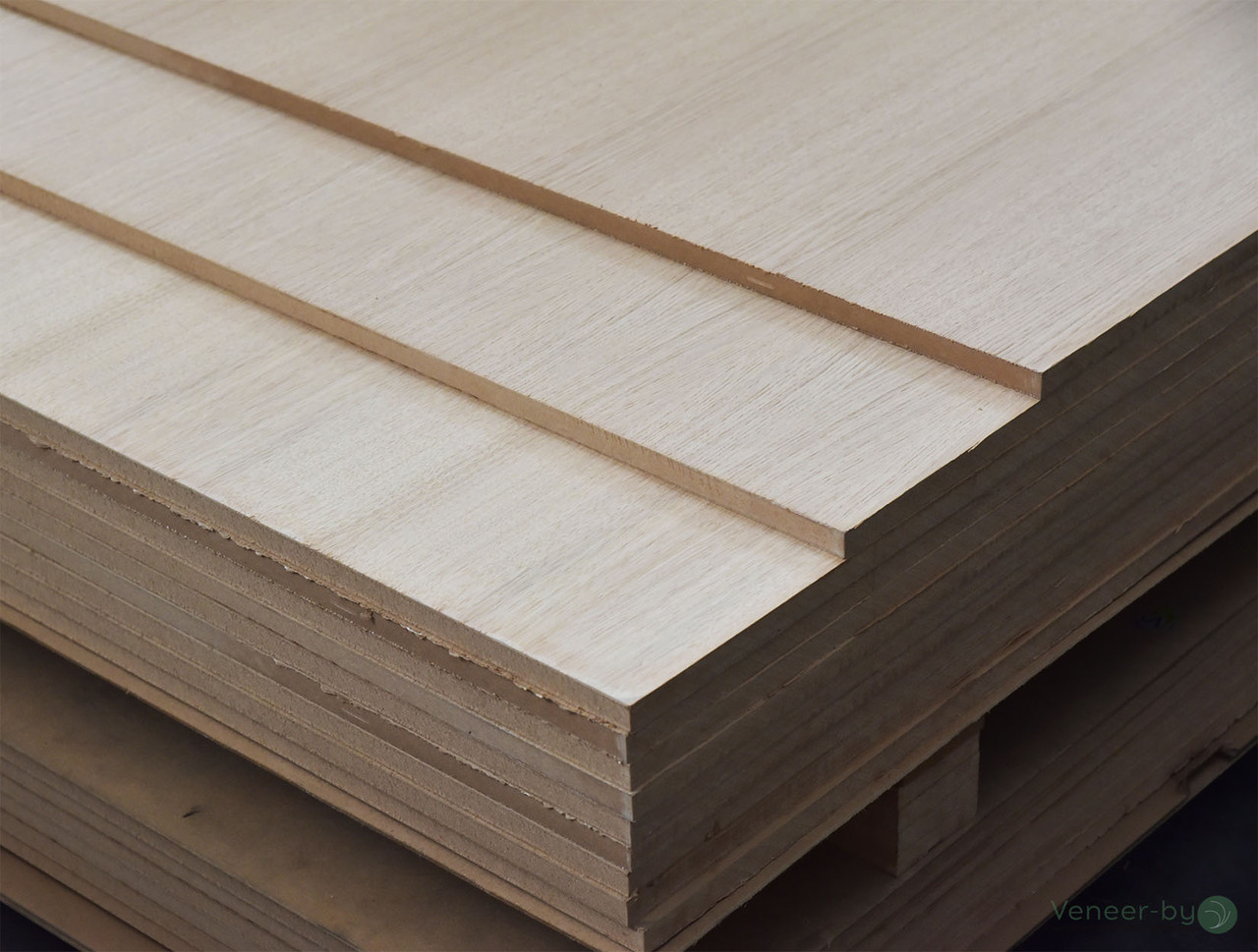How is veneered MDF made?
The manufacture of such material is a rather laborious process, however, with the help of high-tech equipment and the skill of workers, excellent results are achieved. The factories use fully automatic mechanisms and high quality raw materials.
Natural veneer comes to factories in rolls or packs, packaging is carried out taking into account the required dimensions and properties that will differ in the final product. Experienced craftsmen put prepared veneer sheets on the prepared and treated MDF surface with a special adhesive. When using roll raw materials, gluing is carried out in one step. When gluing veneer, which is brought in in packs, a special technology is used. It consists in longitudinal and transverse gluing, which resembles a fish bone. There are other gluing methods. But all processes are necessarily strictly controlled by employees and using a computer that carries out measurements and settings. The veneer is glued to MDF boards with an adhesive. The next step is press drying, after which the surface still needs to be sanded and varnished. Today, many industries use a high temperature drying press. It makes it possible to glue veneer on many MDF boards in a short time, therefore, much less time and money is spent on warehouses for drying the final product. Provided that the surface of MDF is uneven, for example, on curly door plates, the technique of vacuum gluing is used. However, this process is more costly and time-consuming.
After all these procedures, the resulting veneer plate must be sanded first across, and then along. Only after that a perfectly smooth surface is obtained. In addition, in order for the varnish to lay down more evenly, the veneered surface must be ironed with a hot roller. This must be done because there is a possibility that the wood grain on the veneer will rise during the application of paints and varnishes. As a result of this painted surface, bumps or depressions can form, which greatly spoil the appearance and quality of the final product. For this reason, ironing technology is used, during which excess fibers are soldered to the surface, and it becomes completely smooth.
The slab is painted with transparent or opaque varnish, colored paint, as well as special wax.
MDF veneering: technology
Veneering is a decorative way of finishing chipboard and MDF boards. After the production stage, the sheets are sorted by shade, texture, thickness. Surfaces are treated with putty and sanded. Then a special composition is applied and the veneer is connected according to one of the technologies, which implies gluing a veneer "shirt" to the base by means of:
- Vacuum connection.
- Cold method using special compounds: resins, glue.
- By pressing and heat treatment.
Panel veneering can be one-sided and two-sided. When working only with the front side, after the glue and sawdust have dried, the base may bend. In order to maintain the shape, paper or an identical sheet is glued from the back. The result is high-quality products that look no different from natural wood, but with the best performance:
- strength;
- resistance to atmospheric phenomena;
- lack of deformation.
Veneer classification
There are several methods of wood processing, with the help of which veneer is obtained:
- Planing. In this case, the material is made from a bar with preservation of the unique pattern of Karelian birch, walnut, ash, pine, larch. From the attached log, movable blades cut thin plates of 0.3 -5 mm, which acquire a special aesthetics after planing. For this reason, the material is in demand in furniture factories for the manufacture of wall panels.
- Sawing. Plates with a thickness of 1, 2 to 10 mm are obtained after processing on a band-dividing machine by sawing. The method is considered costly due to the large amount of waste, however, the naturalism and beauty of the canvas are indispensable for covering parquet boards, in the manufacture of doors and designer furniture, therefore it is popular.
- Peeling. Differs in the cut-off principle. Spiral rotation of the log around the static blade allows you to get a tape up to 2.5 m, which is then cut, dried, sorted and veneered. Also used in the manufacture of laminated veneer lumber. The method is focused on working with pine, ash, alder, beech, elm, poplar.
Comparison of characteristics and technologies will allow solving the dilemma of which veneer is better - today sliced veneer is most in demand.
Wall panels in walnut and other wood finishes compete with stylish boiser made from solid wood. This became possible due to the exclusive design of surfaces, durability, low cost. Moreover, the varnish finish applied in different ways (with open, closed pores, glossy effect) enhances the impression of the finish and affects the durability of the wall panels.
How is veneered MDF made?
The manufacture of such material is a rather laborious process, however, with the help of high-tech equipment and the skill of workers, excellent results are achieved. The factories use fully automatic mechanisms and high quality raw materials.
Natural veneer comes to factories in rolls or packs, packaging is carried out taking into account the required dimensions and properties that will differ in the final product. Experienced craftsmen put prepared veneer sheets on the prepared and treated MDF surface with a special adhesive. When using roll raw materials, gluing is carried out in one step. When gluing veneer, which is brought in in packs, a special technology is used. It consists in longitudinal and transverse gluing, which resembles a fish bone. There are other gluing methods. But all processes are necessarily strictly controlled by employees and using a computer that carries out measurements and settings. The veneer is glued to MDF boards with an adhesive. The next step is press drying, after which the surface still needs to be sanded and varnished. Today, many industries use a high temperature drying press. It makes it possible to glue veneer on many MDF boards in a short time, therefore, much less time and money is spent on warehouses for drying the final product. Provided that the surface of MDF is uneven, for example, on curly door plates, the technique of vacuum gluing is used. However, this process is more costly and time-consuming.
After all these procedures, the resulting veneer plate must be sanded first across, and then along. Only after that a perfectly smooth surface is obtained. In addition, in order for the varnish to lay down more evenly, the veneered surface must be ironed with a hot roller. This must be done because there is a possibility that the wood grain on the veneer will rise during the application of paints and varnishes.As a result of this painted surface, bumps or depressions can form, which greatly spoil the appearance and quality of the final product. For this reason, ironing technology is used, during which excess fibers are soldered to the surface, and it becomes completely smooth.
The slab is painted with transparent or opaque varnish, colored paint, as well as special wax.
Despite the fact that there are huge reserves of forest in the world, wood is still a valuable and expensive material. Therefore, veneering MDF profiles or panels is the most profitable solution than solid wood.
Manufacturing features
Kitchens made of veneer are MDF boards with a thin coating of 0.6–1 mm. MDF, that is, a finely dispersed fraction of wood, is, in fact, small wood chips impregnated with paraffin or lingin, and pressed under the influence of high temperature into a monolithic panel. Veneer is a thin cut of natural wood of elite species, which is glued to MDF, after which the veneered surface is opened with varnish or enamel.
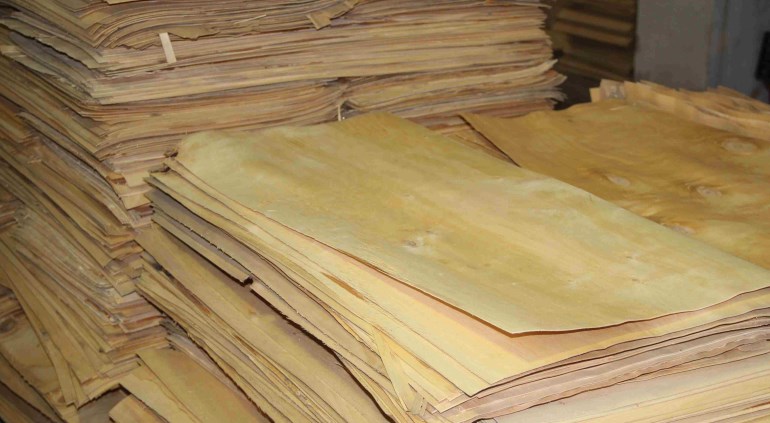
It looks like a veneer obtained as a result of wood peeling
- Oak. One of the strongest and most durable materials available in a wide range of shades from black to white. Such a veneer kitchen, a photo of which can be viewed on the website, is considered the most popular.
- Pine. It has a light shade and belongs to soft wood species, so pine veneer is a more budget option.
- Alder. For the kitchen, MDF alder veneer is just a godsend, since this material is very moisture resistant. This means that the furniture will not deform over time.
- Cherry. It has a noble red tint, so the veneer from it gives the interior luxury and gloss.
- Ash. It is very suitable for small kitchens, since the light tone visually increases the size of the room.
- Nut. These veneered kitchens have a rich color palette. Hardwood is similar in properties to oak products.
- Zebrano. Due to its striking striped color, the material belongs to the elite and is found in luxury homes.

Only the central parts can be faced with veneer, and the frames will be made of wood
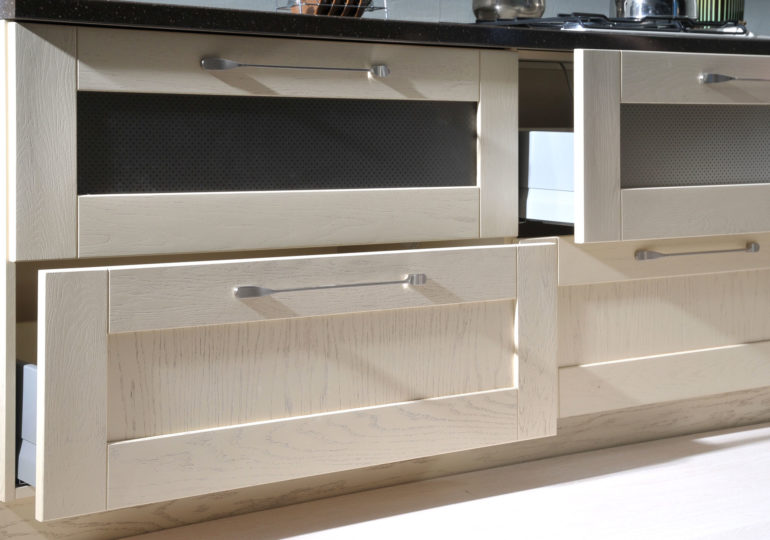
What do we offer?
The White Ash company presents to your attention a wide range of high quality materials. We manufacture and sell veneered (veneered) chipboard, the surface of which is covered on one or both sides with natural wood veneer. You can buy from us really high quality materials that can replace products from valuable wood. The advantages of veneered chipboard boards are that they can be perfectly processed and also have excellent strength characteristics. When compared with veneered MDF, it is worth noting that chipboard absorbs moisture better + has a lower cost.
Veneered chipboard boards are covered with sliced veneer, whose thickness is from 0.55 to 0.7 mm... Our price list indicates the thickness of the chipboard without taking into account the thickness of the veneer.
Depending on the workload of our production, the production time will be from 3 to 10 working days.
Colors
The colors of the slabs are offered in a wide range, so everyone can find what meets the design needs. You can choose transparent and translucent slabs, on which a lace pattern is applied. These slabs imitate glass and stained glass; this unusual decor is often used as a separate component that complements the overall interior. The dense monochrome coating of veneered MDF boards is presented in pastel and bright colors. If you need a light facade, you can safely choose panels with this design. The range of solutions can reach 200 options, while the execution can be both smooth and textured.
It should be noted that slabs in white are presented in several shades, which allows you to achieve an ideal design solution and interior decoration. Of course, slabs for solid wood, metal or natural stone are in great demand. This effect is created using films, patination, brushing and embossing.
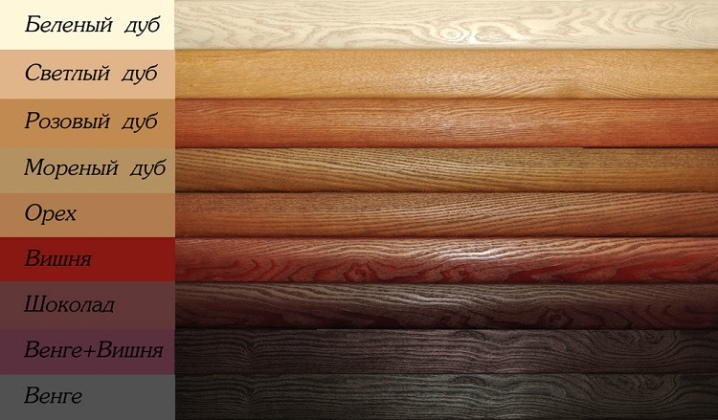
Veneer: technology and methods of making the material
The word "veneer" in translation from German into Russian means "wood chips". This is a thin cut of natural soft and hard wood with a thickness of up to 3 mm, which is glued to the base using glue, epoxy resin or professional mortars. For the base, you can use plywood, chipboard or MDF. The last version of the finely dispersed fraction of wood is most in demand, since it is a dense panel, the service life of which significantly exceeds other materials. Chipboard is loose, so the veneered facade can peel off over time.
The use of plywood is not very cost-effective for kitchen sets, since such a basis is fragile. After gluing the panels and veneers, the facades acquire a solid look of furniture made of solid wood. Outwardly and to the touch, such an imitation is no different from the original, therefore it looks luxurious and expensive. For durability and improvement of technical characteristics, the veneered surface is opened with varnish or enamel. Such protection prevents moisture penetration and better protects furniture from the harmful effects of sunlight and mechanical damage, which is so necessary for the kitchen.
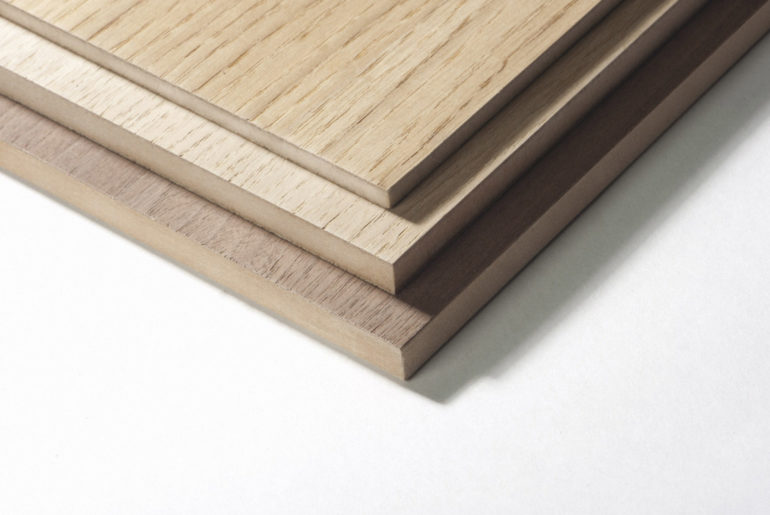
Veneered boards can look like solid beech, oak or other types of wood.
The history of veneer origin dates back to 1819, when the peeling machine was first invented in the Russian Empire. Later, the tool was improved by the Germans, and over time, new methods of extracting thin sheets of wood appeared. Veneered material is used for the manufacture of musical instruments, skateboards, for car tuning. Today there are 3 types of veneered wood according to the method of production.
- Peeled. This is the most common method of making veneer using a peeling machine. After special processing, short logs are cut in a spiral. For a veneered board, the most attractive cuts with beautiful patterns are chosen, the thickness is regulated by the master. Such peeled sheets are usually made from oak, pine, alder, birch.
- Sliced. For this method of planing, the most valuable tree species are used: beech, mahogany, walnut, Karelian birch. In the process of work, the wood is planed in different directions to make the drawing more unique and original. Depending on this, tangential, radial, tangential-end and radial-tangential veneers are distinguished. Such kitchen facades look expensive and aristocratic.
- Sawed. Manufacturing involves working on a plywood saw. A lot of material is spent on sawdust, so the cost of veneered wood sheets is higher than in other options for obtaining veneer. Coniferous trees are taken as a basis.
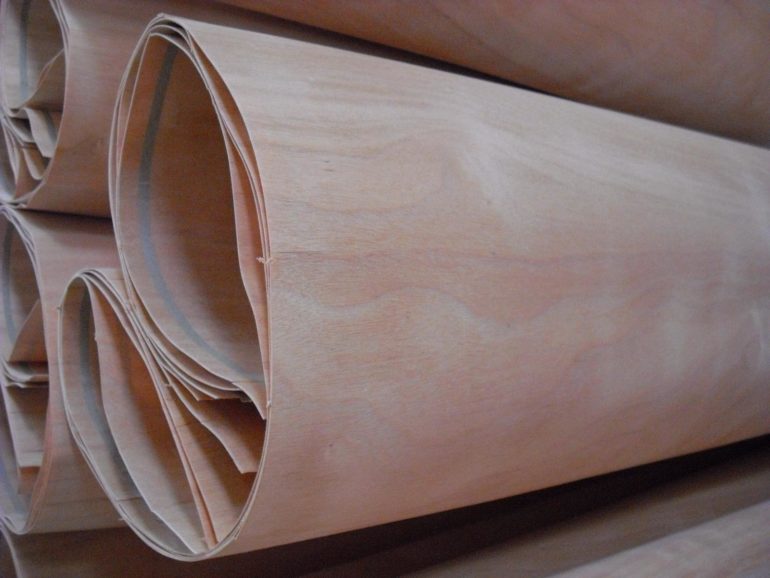
Rotary cut birch veneer
Design examples
Decorating the walls in the office with dark veneer adjusts to a business-like mood, does not distract from serious issues. The natural wood texture is emphasized by the contrast with the white color of the stairs and furniture.
Decorating a bedroom in muted tones of natural wood is an excellent design move that provides not only beauty, but also functionality of the interior. Details in the form of competent lighting, furniture, an original night light complete the composition.
It is enough to highlight a small area in the room with veneer to create an atmosphere of harmony and naturalness in it, necessary for relaxation
This is especially important in the bedroom.
The design of the fireplace area with light veneer emphasizes the dignity of the fireplace itself.It also harmoniously combines with the plastered walls located "next door".
In the decoration of walls and furniture, you can use the same shades. Thanks to this, a very harmonious atmosphere of the business office is created.
The living room in a country house, finished with dark veneer, matching the ceiling and matching wooden furniture, will become a favorite resting place for respectable people who value luxury. A wide variety of details make the furnishings complete.
You can learn how to decorate walls with MDF panels from the video below.
Peculiarities
Wood with a thin cut is called veneer. To obtain veneered material for further production, modern equipment is used, with which the raw material is sawn or peeled. Elite wood species are often chosen for this. The appearance of MDF is no different from ordinary boards. The main advantage of this material is its cost, which is much more affordable than the price of natural solid wood. The veneer is covered with a special varnish, which creates protection against mechanical damage and moisture. Furniture made of such material will look stylish and noble, fitting into any interior.
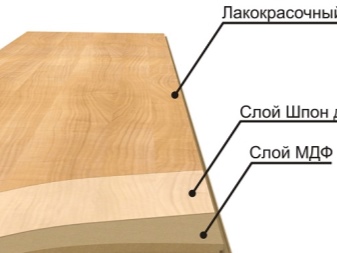
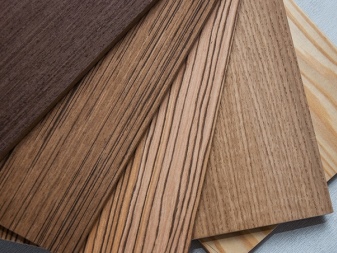
A distinctive feature of veneer from other types of finishing materials is its high level of environmental friendliness. Even when exposed to high temperatures, the wood produces non-toxic and completely harmless lignin, which confirms the naturalness of the material.
Noting the advantages of veneer, it is important to highlight the ease of caring for such products, since it is enough to use a napkin to remove dirt and dust. Low weight allows you to independently assemble furniture products from MDF boards
In addition, much less raw materials are consumed in the manufacture, and this has a positive effect on the preservation of forests. The application of veneer allows you to obtain a beautiful textured material from which stylish furniture is created. A facade covered with paint and varnish will last much longer, while maintaining a presentable appearance.
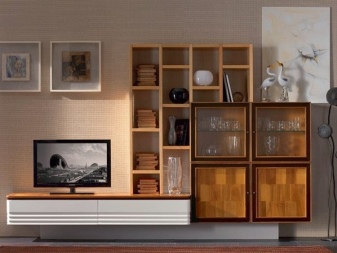
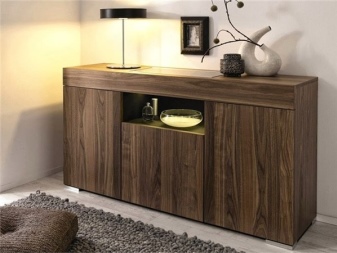
Veneer classification
There are several methods of wood processing, with the help of which veneer is obtained:
- Planing. In this case, the material is made from a bar with preservation of the unique pattern of Karelian birch, walnut, ash, pine, larch. From the attached log, movable blades cut thin plates of 0.3 -5 mm, which acquire a special aesthetics after planing. For this reason, the material is in demand in furniture factories for the manufacture of wall panels.
- Sawing. Plates with a thickness of 1, 2 to 10 mm are obtained after processing on a band-dividing machine by sawing. The method is considered costly due to the large amount of waste, however, the naturalism and beauty of the canvas are indispensable for covering parquet boards, in the manufacture of doors and designer furniture, therefore it is popular.
- Peeling. Differs in the cut-off principle. Spiral rotation of the log around the static blade allows you to get a tape up to 2.5 m, which is then cut, dried, sorted and veneered. Also used in the manufacture of laminated veneer lumber. The method is focused on working with pine, ash, alder, beech, elm, poplar.
Comparison of characteristics and technologies will allow solving the dilemma of which veneer is better - today sliced veneer is most in demand.
Wall panels in walnut and other wood finishes compete with stylish boiser made from solid wood. This became possible due to the exclusive design of surfaces, durability, low cost. Moreover, the varnish finish applied in different ways (with open, closed pores, glossy effect) enhances the impression of the finish and affects the durability of the wall panels.
MDF production
The basis of raw materials for MDF is wood, as well as waste from the logging and woodworking industry, which are shredded and then processed with high pressure steam.
After wiping on the rotating discs of the defibrer, processing is carried out with special binders using glue, paraffin and lignin. After gluing and drying, the material is ready for use.
During production, we observe all the nuances of the technological process, paying close attention to each stage:
Advantages of using:
- Ecological cleanliness. Our products are completely harmless to human health;
- Ease of processing, as the material is sufficiently soft;
- Long service life combined with ease of maintenance;
- Increased moisture resistance (compared to chipboard), due to which it can be used in rooms with high humidity, but without direct contact with water;
- Resistant to fungi, mold and the appearance of harmful microorganisms.
Where is veneered MDF used?
Due to their excellent performance characteristics and increased strength, our products are in demand in the production of:
- furniture and decorative items;
- commercial equipment;
- countertops, facades;
- doors;
- enclosures of acoustic systems;
- as insulation and wall covering, etc.
Where is it applied?
The most demanded area of application of veneered MDF is the production of furniture facades. Finishing kitchen sets with this material is in great demand, but it all depends on what kind of wood was taken as a basis. For example, for the manufacture of doors, walnut is ideal, which has a light and pleasant grayish tint. As for pine MDF boards, they are often used in the production of expensive and exclusive furniture.
Oak is distinguished by its durability, therefore, such veneered material is often used for finishing door structures. A maple product is ideal for interior decoration in light colors. Products made of MDF boards will serve for a long time, while maintaining a presentable appearance, if you take care of the surface and initially choose a manufacturer that guarantees quality
Veneered facades attract a lot of attention not only due to excellent characteristics, but also aesthetics, the choice of texture and textured patterns, and other advantages
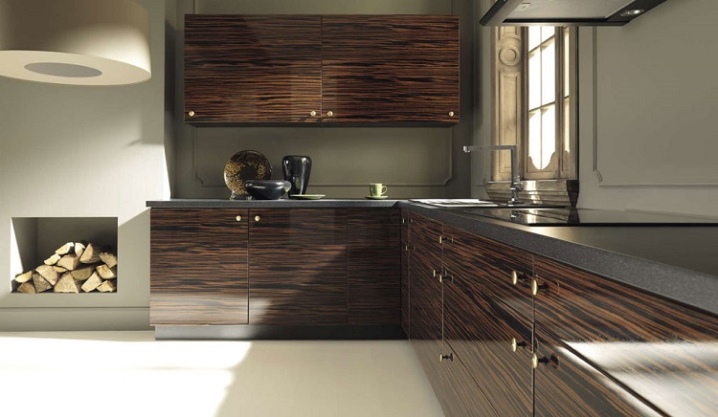
In the next video, you will see the installation of veneered MDF panels on the wall.
Advantages and disadvantages
The kitchen is a place where furniture is exposed to special negative influences: temperature drops, grease stains, soot deposits will certainly accompany the cooking process. Housewives try to select a set that will most steadfastly endure all unfavorable factors, will not deteriorate or deform.
- Durability. Lacquered veneer fronts not only look stylish, but are also very durable and durable. Such a surface is not easy to scratch, it is shockproof, is not afraid of moisture, steam, direct sunlight.
- Maintainability. Furniture can be easily restored even at home. If there are scratches, they can be sanded, if there are chips, they can be removed using the same veneered patches. With regard to film or plastic, such surfaces cannot be repaired after serious damage.
- Acceptable price. Compared to solid wood, veneer kitchens are much cheaper, and in terms of characteristics, veneer significantly outperforms its expensive competitor.
- Stylish design. Veneered fronts look great in both small and small kitchens, as they look sleek and less bulky. The plasticity of the veneer material allows you to create unique shapes, so the furniture fits into the classic and modern interior.It is also possible to choose any color and texture you like, to make the surface matte or glossy. Veneer goes well with glass, acrylic, metal or plastic.
- Easy care. Natural wood sheets need the same care as solid wood. Stains can be easily removed with a damp cloth or sponge. In no case should you use aggressive household chemicals with abrasive particles so as not to damage the surface. It is advisable to use a simple soap solution or special furniture sprays. They will help to maintain shine and attractive appearance for a long time. Designers recommend choosing lighter shades, since stains and dust are much more noticeable on dark brown, black, dark blue facades.
- Environmental friendliness. The kitchen is the place where a person spends most of their time, so the quality of the material should come first. Veneered facades, unlike film or plastic, do not pose a threat to human health, since no harmful substances and chemical compounds are used in the manufacture.
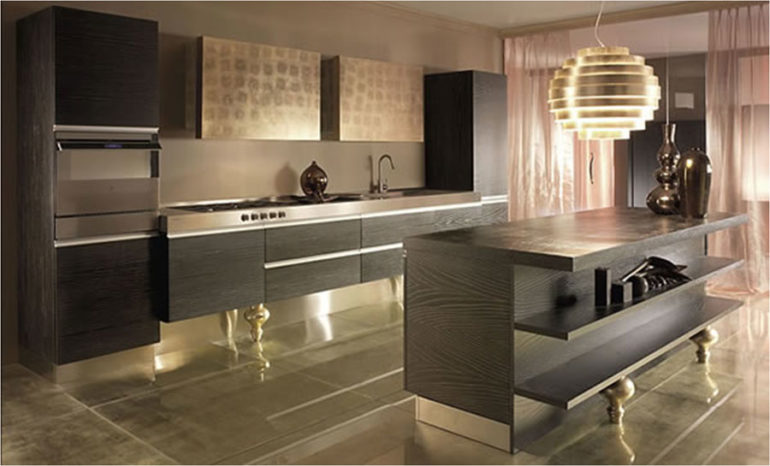
Veneered facades are strong, durable and do not deform
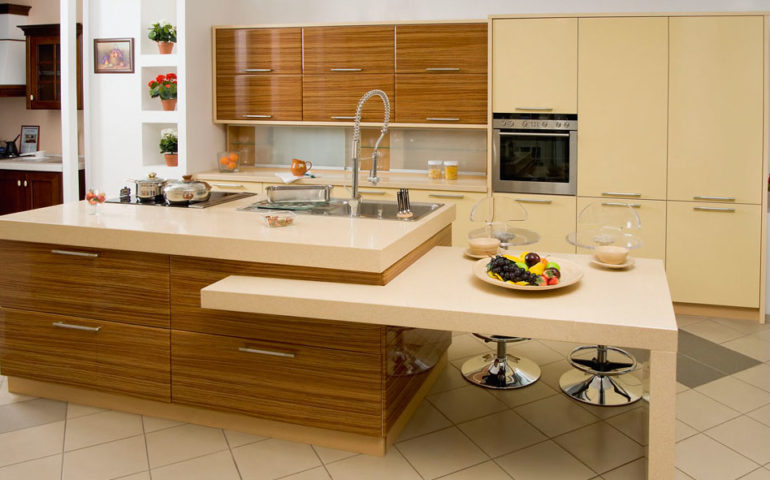
Veneer varnishing provides additional protection for the facade
- The quality of a kitchen set is difficult to assess at first glance. Only during operation can one understand how conscientiously the manufacturer made the veneer. If raw materials were used in the work, then over time, the facades may deform, and the veneer may peel off from the substrate. When buying a headset, one should give preference to reputable companies that give a guarantee for the furniture purchased. However, it is necessary to adhere to certain rules for the care of the headset, otherwise the manufacturer may withdraw from itself warranty obligations in case of non-compliance with the instructions.
- Unfortunately, like any wood, veneer wood is susceptible to the negative effects of ultraviolet rays. Over time, facades can fade, for example, white becomes gray. Sanding and updating the coating will help solve the problem. Plus, it's a good way to tweak your kitchen design a bit and experiment with shades. For small kitchens, it is recommended to choose light colors; in large kitchens, you can combine different colors.
- The price of veneer significantly exceeds the price of plastic or vinyl coated products. Increasing consumer demand and wood shortages also lead to a constant and systematic increase in the cost of furniture from year to year.
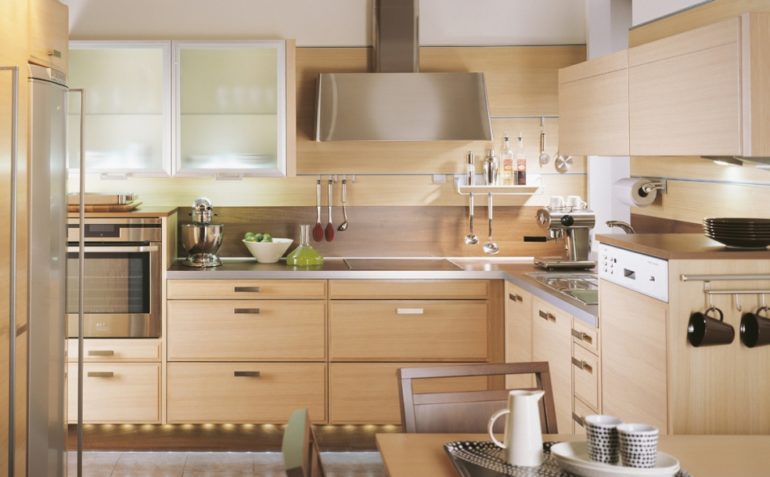
Veneered panels are often combined with others, for example, with film or enamel
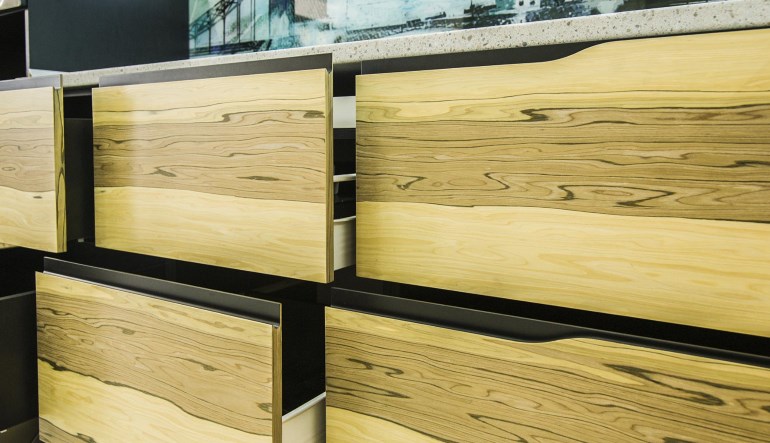
MDF veneer
What can be made of such material, besides furniture? Various veneer products are perfect as finishing materials. In building supermarkets, a variety of profiles, panels, skirting boards are sold, which will be a great addition or even the main accent of the interior of your apartment.
With the help of such panels, you can finish all walls and ceilings, you can do it partially.
Often, of all the profiles of such a plan, cornices, baguettes, as well as MDF veneered skirting boards for the floor or ceiling are used. They are perfectly combined with other finishing materials, for example, decorative plaster, stucco, wallpaper or laminate.
The veneered walls will be the highlight of any interior. Today this type of finish is very popular. Veneer is appreciated primarily for its versatility. The use of veneer is very wide. It is used for wall decoration, flooring, furniture and doors. In addition, such material is often used on yachts, terraces, offices and even expensive car interiors.
The second advantage is environmental friendliness. Natural finishing materials do not pose any danger to human health, they do not cause allergies. Wood motives always look expensive and elegant.
There are a huge number of shades and textures of veneer panels. Unique panels, mosaics, and inlay are made from veneers of different types of timber.
Also, the advantages of veneer include:
- easy care. You just need to wipe the veneered elements with a napkin without the use of detergents and cleaning agents
- light weight. Such materials are much lighter than those of a solid board.
- rational use of natural materials. For the manufacture of veneered furniture, much less wood is consumed. Therefore, buying such furniture, you save the forest.
What is this material?
Veneer is a very thin cut of wood, obtained using a special machine. This decorative layer is glued to the base from which the wall panel is made.
In addition to chipboard or plywood, MDF can serve as the basis. The composition of such a panel includes crushed shavings and other woodworking waste, which are dry pressed. The advantage of the material is that it does not use formaldehyde-based adhesives. Here, the lignin contained in the algae is used.
This finishing material has other advantages:
- excellent technical characteristics;
- affordable price;
- ease of installation;
- practicality;
- environmental friendliness.
Veneered panels come in not only different shapes and sizes, but also products differ in texture.
Where can you apply?
Veneer trim can often be seen in public places (shops, libraries, offices). In everyday life, veneered panels are most often used to create the interior of the hallway, loggia. In a country house, such a finishing material is also suitable for cladding the walls of a bedroom or living room. It makes it possible to create a "rich" design with an imitation of natural oak or other valuable species.
Some people associate this kind of decoration with Soviet times, when almost all interiors of office buildings were decorated with wall panels "like wood". Therefore, many consider this approach to the design of premises outdated. Nevertheless, modern designers are bringing back the fashion for such decoration, creating an atmosphere in homes that is quite in line with the present day.


